Contents
 When the wave of the first spring mushrooms descends, a short period of calm sets in in the forests of the Moscow Region. But already in July, mushrooms such as boletus, boletus, boletus, mossiness mushrooms and goats, russula, valui, lactic and rubella begin to appear in the Moscow region. Inedible species can also be found in the forests: gall mushrooms, floats and pale grebes.
When the wave of the first spring mushrooms descends, a short period of calm sets in in the forests of the Moscow Region. But already in July, mushrooms such as boletus, boletus, boletus, mossiness mushrooms and goats, russula, valui, lactic and rubella begin to appear in the Moscow region. Inedible species can also be found in the forests: gall mushrooms, floats and pale grebes.
The middle of summer is the time of fragrance and flowering of all nature. Although the month of July is not the peak of “quiet hunting”, but it is in this month that you can make the first test forays into the forest.
About what mushrooms grow in July, and how they look, is described in detail on this page.
Mushrooms from the genus Borovik
Boletus maiden, or appendage (Boletus appendiculatus).
Habitats: these mushrooms grow in the forest in July singly and in groups in mixed plantings with beech, oak, hornbeam, and also among firs.
Season: from June to September.

The cap is 5-20 cm in diameter, in young mushrooms it is convex, cushion-shaped, then convex. A distinctive feature of the species is a leathery, at first velvety, later even hat of yellow-brown, brown-brown color. The skin is not removed. The cap is matte in dry weather and slimy in damp weather.
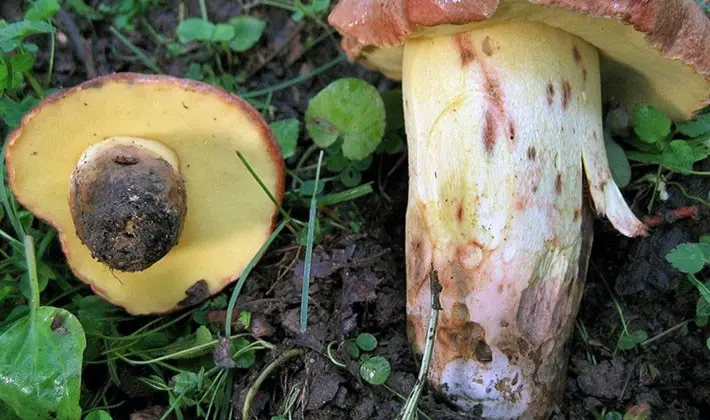
Leg 5-15 cm tall, 1-3 cm thick, lemon-yellow, reticulate, sometimes brownish below. The base of the stem often has a conical narrowing.
The pulp is yellow, fleshy, dense, with a pleasant taste, odorless, turns blue on the cut, with a pleasant taste and smell.
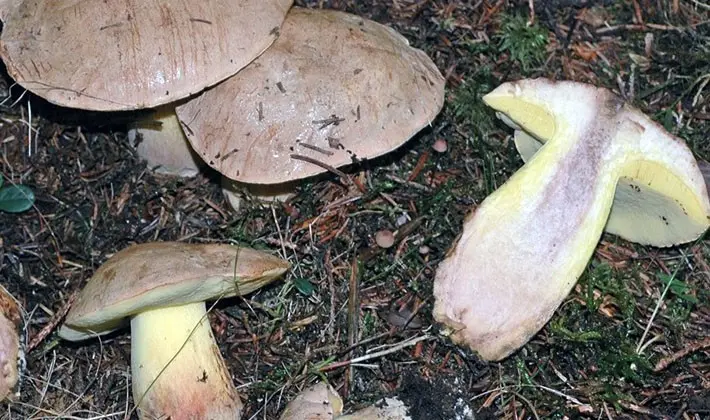
The hymenophore is free, notched, consists of tubules 1-2,5 cm long, which are first lemon-yellow, golden-yellow, later yellow-brown. When pressed, the tubes become blue-green. Honey colored spore powder.
Variability: the color of the cap varies from golden brown to yellow-brown.
There are no toxic twins. The shape of the cap and the color of the stem are similar to the edible porcini mushroom, or royal boletus (Boletus regius), which differs in a thicker stem and the color of the cap with shades of red.
Cooking methods. Mushrooms are dried, pickled, canned, soups are prepared.
Edible, 1st category.
Boletus boletus (Boletus pascuus).
Habitats: in glades, pastures rich in organic matter, next to mixed forests.
Season: from June to September.
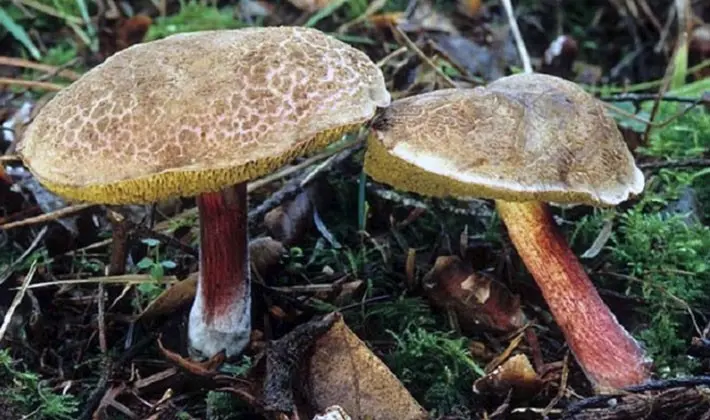
The cap is 3-10 cm in diameter, at first hemispherical, later cushion-shaped and convex. A distinctive feature of the species is a fissured and spotted yellow-red, burgundy-red, yellow-brown cap, velvety at first, later smooth. The skin is not removed.
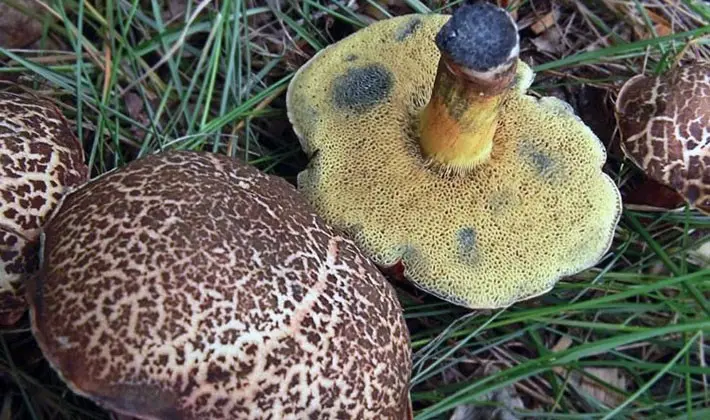
Leg 3-8 cm high, 7-20 mm thick, cylindrical. The color of the legs is yellow above, reddish below.
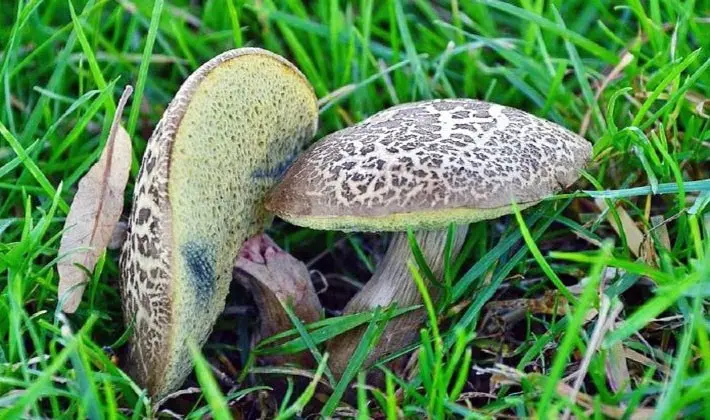
The flesh is dense, whitish at first, later light yellow, turns blue on the cut, the taste and smell are pleasant.
The tubular layer is free, at first yellow, later greenish-yellow, when pressed it acquires a bluish tint. Spores are olive brown.
Variability: the color of the cap varies from red-brown to brown-brown.
Similar types. The boletus boletus is similar to the variegated flywheel (Boletus chrysenteron), which is distinguished by a uniform color of the cap.
Cooking methods: pickling, salting, frying, soups, drying.
Edible, 2th category.
Белый гриб – это гриб из рода Боровик. У российских грибников особое отношение к белым грибам. Встреча с ними завораживает и поднимает настроение. Появляется желание их фотографировать и искать еще и еще. В последнее время все чаще фотографируют найденные белые на сотовый телефон. Эти замечательные грибы не только красивые, но полезные и лечебные.
White mushroom, spruce form (Boletus edulis, f. edulis).
Habitats: singly and in groups in coniferous and mixed with spruce forests.
Season: from early July to mid-October.
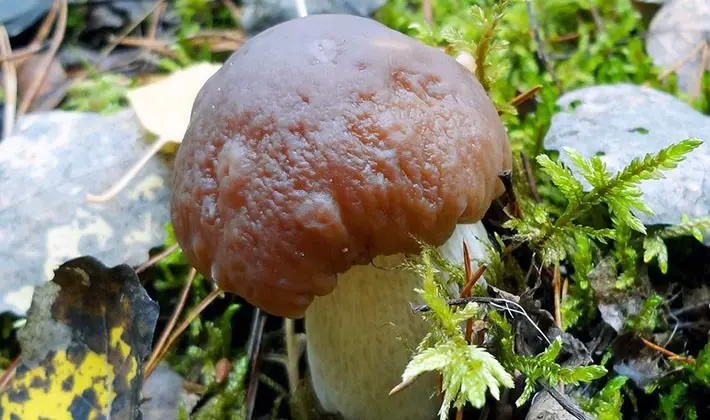
The cap is 4-16 cm in diameter, in young mushrooms it is convex, cushion-shaped, then flatter, smooth or slightly wrinkled. In wet weather, the cap is slimy, in dry weather it is shiny. A distinctive feature of the species is the color of the cap – reddish-brown or chestnut-brown, as well as the presence of places with lighter and darker areas. The edge of the cap is even, in young mushrooms it is slightly tucked. The cap is thick and fleshy.
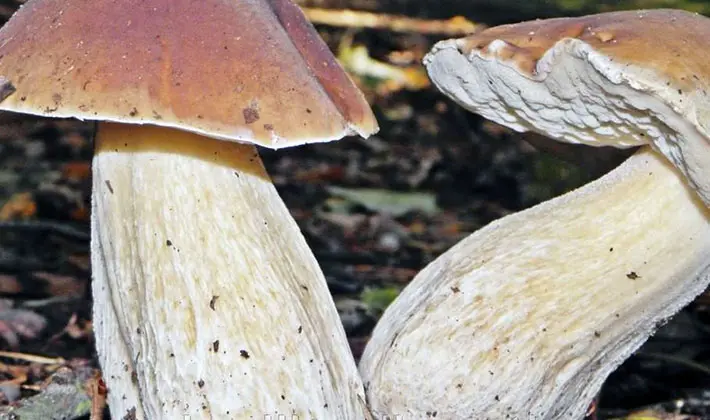
The leg is long, light with a pale mesh pattern, 6-20 cm tall, 2-5 cm thick, expanded or club-shaped in the lower part, more intensely colored in the upper part, white below.
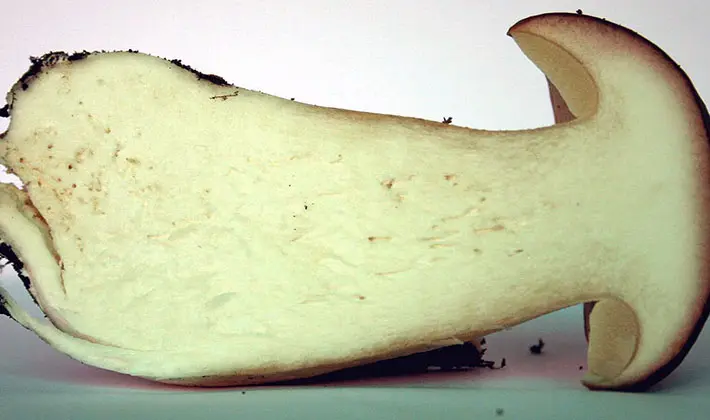
Pulp. The second distinctive feature of the species is a very dense pulp, white, which does not change color at the break. There is no taste, but it has a pleasant mushroom smell.
The hymenophore is free, notched, consists of tubules 1-2,5 cm long, white, then yellow, with small rounded pores of the tubules.
Variability: the color of the cap varies from chestnut brown to light chestnut and bright brown, the stem in the upper part can have a color from light brown to reddish.
There are no toxic twins. The size and color of the cap are similar to inedible bile mushrooms (Tylopilus felleus), in which the flesh has a pinkish tinge and a scalding bitter taste.
Edible, 1th category.
White mushroom (common) (Boletus edulis).
Habitats: singly and in groups in mixed and coniferous forests, forest parks.
Season: from June to mid-October.
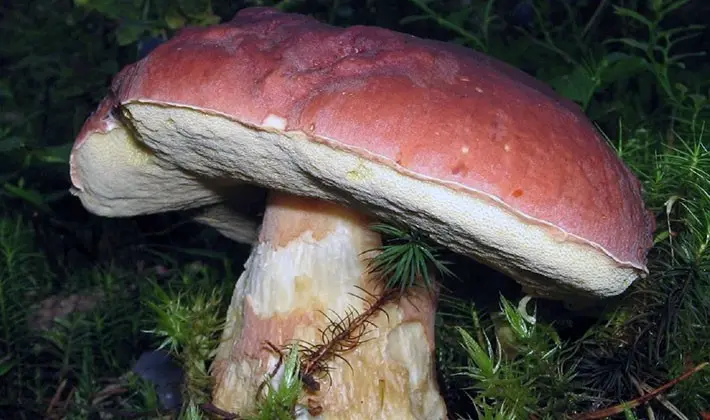
The cap is 5-25 cm in diameter, in young mushrooms it is hemispherical, then convex and then flatter, smooth with folded edges. The skin is velvety-wrinkled, shiny and slightly sticky in wet weather. Hat color – dark brown, light brown, brick red. The skin is not removed. The edge of the cap is even, in young mushrooms it is slightly tucked. The cap is thick and fleshy.
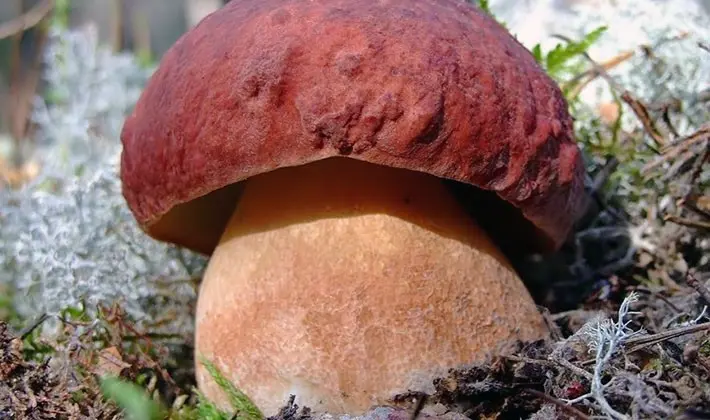
The leg is massive, dense, cylindrical, sometimes thickened below or even tuberous, of medium and large length, light with a dull light brown mesh pattern in the upper part, and smooth and lighter in the lower part. Mushroom height 6-20 cm, thickness 2-5 cm.
The flesh is firm, white in young specimens and spongy. Then it changes color to yellowish-greenish. It has no taste, but has a pleasant mushroom smell.
The tubules are narrow and long, not adherent to the stem and easily separated from the cap.
Variability: the color of the cap varies from whitish to dark brown and even grayish. The stalk at the top can be light yellow to light brown in color.
There are no toxic twins. Similar are the inedible bile mushrooms (Tylopilus felleus), in which the flesh has a pinkish tint, an unpleasant odor and a very bitter taste.
Cooking methods: drying, pickling, canning, soups.
Edible, 1th category.
White mushroom, mesh form (Boletus edulis, f. reticulates).
Habitats: singly and in groups in oak and hornbeam forests.
Season: from June to mid-October.
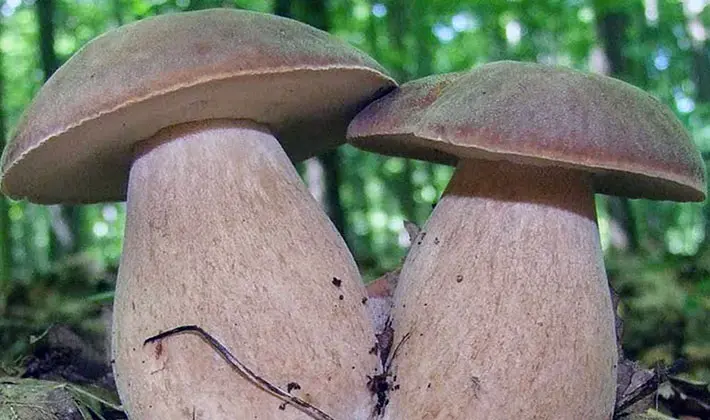
The cap is 4-15 cm in diameter, in young mushrooms it is convex, cushion-shaped, then flatter, smooth or slightly wrinkled. In wet weather, the cap is slimy, in dry weather it is shiny. The color of the cap is brick red, dark brown, brown or light brownish. The skin is not removed. The edge of the cap is even, in young mushrooms it is slightly tucked. The cap is thick and fleshy.
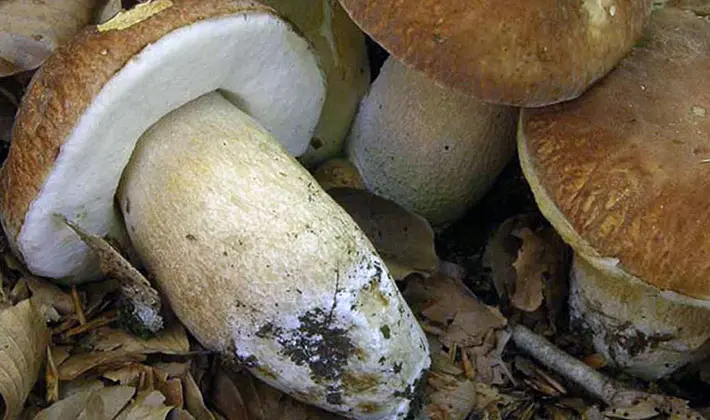
Leg. A distinctive feature of the species is a pronounced mesh on the leg. A light cream mesh is superimposed on a red or brown background. Leg of medium length, 5-13 cm high, 1,5-4 cm thick, widened or club-shaped in the lower part, more intensely colored in the upper part.
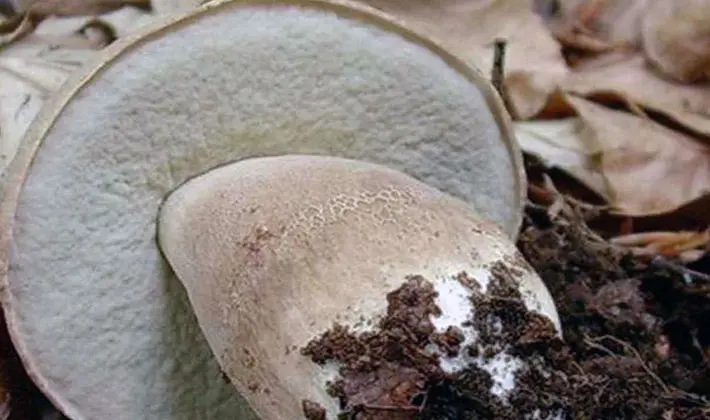
The pulp is dense, white, has no color on a break. It has no taste, but has a pleasant mushroom smell.
The hymenophore is free, notched, consists of tubules 1-2,5 cm long, white, then yellow, with small rounded pores of the tubules.
Variability: the color of the cap varies from dark brown and dark brown to light brownish, and the color of the stem is similar.
There are no toxic twins. The size and color of the cap are similar to inedible bile mushrooms (Tylopilus felleus), in which the flesh has a pinkish tint and a bitter taste.
Edible, 1th category.
White fungus copper (Boletus aereus).
Habitats: in deciduous and mixed forests.
Season: from early July to October.
The cap is 4-10 cm in diameter, in young mushrooms it is convex, cushion-shaped, then flatter, smooth or slightly wrinkled. In wet weather, the cap is slimy, in dry weather it is shiny. A distinctive feature from other white mushrooms is the color of the cap – brownish or dark brown. The edge of the cap is even, in young mushrooms it is slightly tucked. The cap is thick and fleshy.
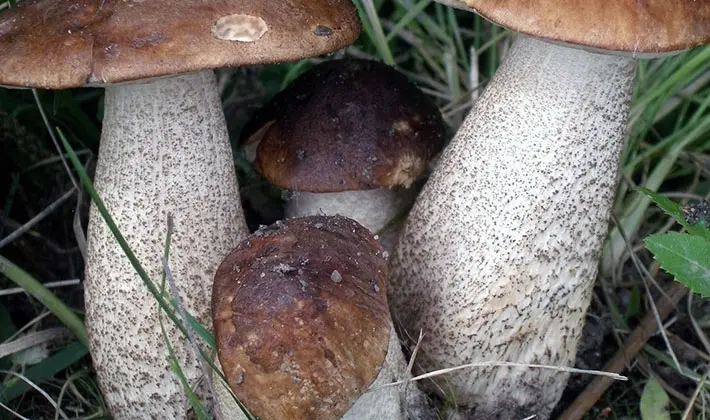
The leg is long, light with a soft mesh pattern, 6-20 cm tall, 2,5-4 cm thick, expanded or club-shaped in the lower part. The leg is covered with light brown stains.
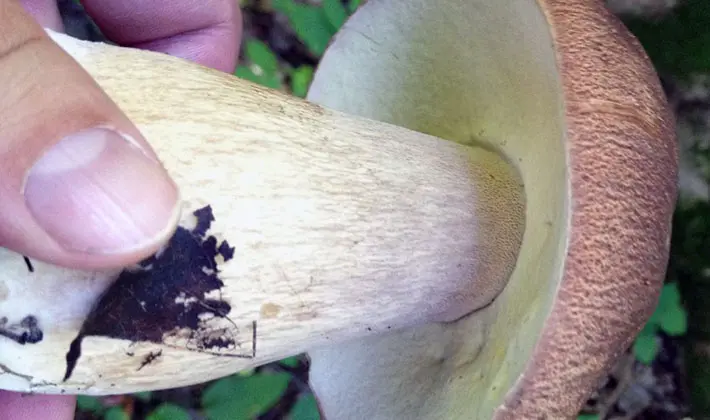
The pulp is dense, white or light yellow in young mushrooms, yellowish in mature mushrooms. When pressed, the color does not change. It has no taste, but has a pleasant mushroom smell.
The hymenophore is free, notched, consists of tubules 1-2,5 cm long, white, then yellow, with small rounded pores of the tubules.
Variability: the color of the cap varies from light brown to dark and bright brown, the stem in the upper part can have a color from light brown to reddish.
There are no toxic twins. The size and color of the cap are similar to inedible bile mushrooms (Tylopilus felleus), in which the flesh has a pinkish tint and a bitter taste.
Edible, 1th category.
Medicinal properties of porcini mushrooms
- They contain more than other mushrooms, vitamin A (in the form of carotene), B1, C and especially D.
- Porcini mushrooms contain the most complete set of amino acids – 22.
- Used to treat ulcers, boils with an aqueous solution.
- They are used for frostbite: the mushrooms are dried (withered), an extract is made and frostbitten areas of the body are treated.
- Dried porcini mushrooms retain all the best healing properties and are a reliable prevention against the occurrence of cancer.
- Improve metabolism.
- They have a general strengthening effect on the body when taking mushroom powder 1 teaspoon per day.
- Reduce blood pressure.
- In porcini mushrooms, the alkaloid hercedin was found, which is taken for angina pectoris, while immunity increases, heart pain decreases.
- White mushrooms contain antibiotics that kill Escherichia coli and Koch’s bacilli that cause diarrhea. They make a tincture to eliminate intestinal infections.
- As an adjuvant, it is used to treat tuberculosis.
- Systematic use helps to eliminate gastrointestinal diseases.
- They contain an increased concentration of riboflavin, a substance responsible for the health and growth of nails, hair, skin and overall health. Riboflavin is especially important for maintaining normal thyroid function.
- Remedy for depression.
- It has long been believed that taking white mushrooms reduces headaches and heals the heart.
Underbird
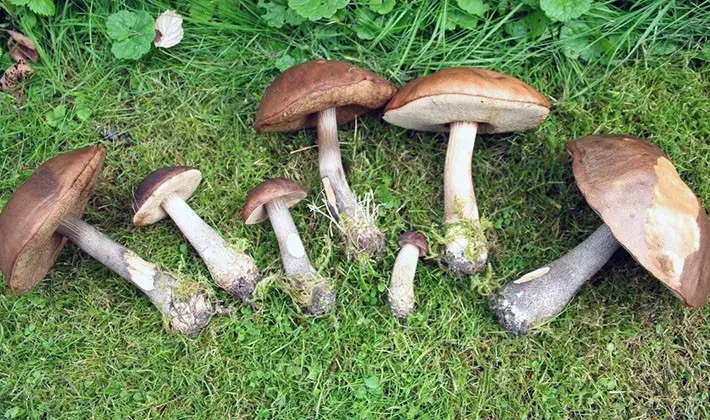
Количество подберезовиков в июле резко возрастает. Теперь они появляются повсеместно: в болотистых местах, рядом с тропинками, на полянках, под деревьями. Преимущество отдается смешанным лесам с березами и елями.
Boletus (birch) marsh (Leccinum holopus).
Habitats: singly and in groups in sphagnum bogs and in damp mixed forests with birches, near water bodies.
Season: from July to the end of September.
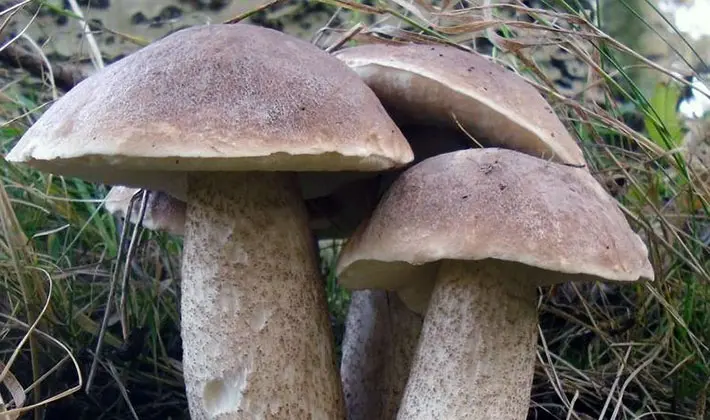
The cap is 3-10 cm in diameter, and in some cases up to 16 cm, in young mushrooms it is convex, cushion-shaped, then flatter, smooth or slightly wrinkled. A distinctive feature of the species is the color of the cap – whitish-cream, grayish-bluish, grayish-greenish.
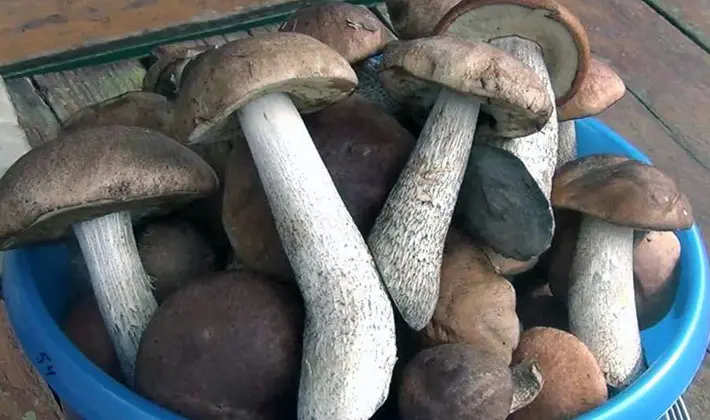
The stalk is thin and long, whitish or grayish, with whitish scales that become brownish when dry. Height 5-15 cm, thickness 1-3 cm.
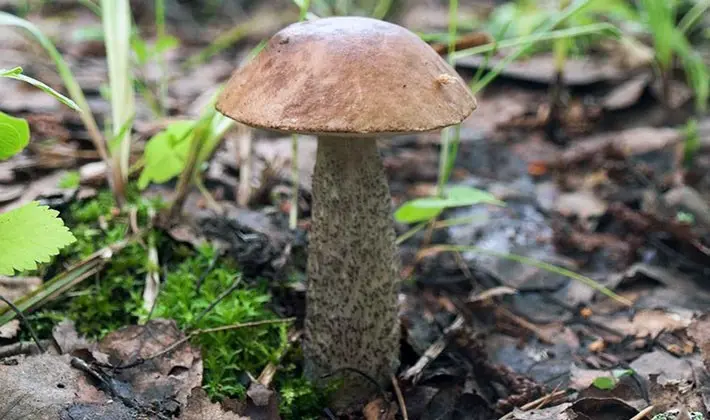
The flesh is soft, white, slightly greenish, watery, bluish-greenish at the base of the stem. The flesh does not change color when cut.
Tubular layer 1,5-3 cm thick, white in young specimens and dirty grayish later, with rounded-angular tube pores.
Variability: the color of the cap varies from white and light cream to bluish-greenish. Tubules and pores are white to brown. The white leg darkens with age, becoming covered with brownish scales.
There are no toxic twins. The size and shape of the cap are similar to inedible bile mushrooms (Tylopilus felleus), in which the flesh has a pinkish tinge and a scalding bitter taste.
Edible, 2th category.
Marsh boletus, oxidizing form (Leccinum oxydabile).
Habitats: singly and in groups in sphagnum bogs and in damp mixed forests with birches, near water bodies.
Season: from July to the end of September.
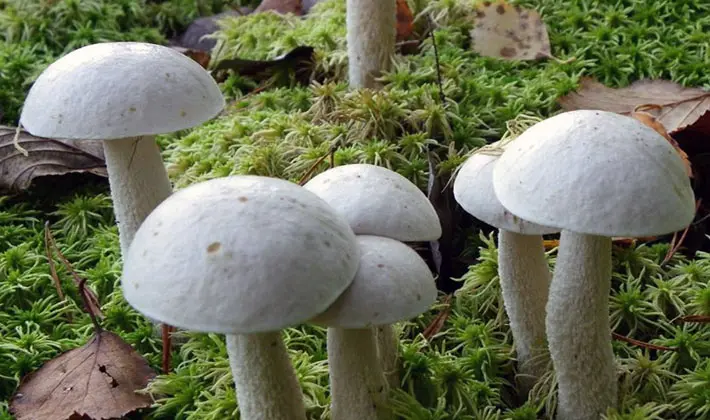
The cap is 3-8 cm in diameter, and in some cases up to 10 cm, in young mushrooms it is convex, cushion-shaped, then flatter, smooth or slightly wrinkled. A distinctive feature of the species is the color of the cap – whitish-cream with yellowish spots.
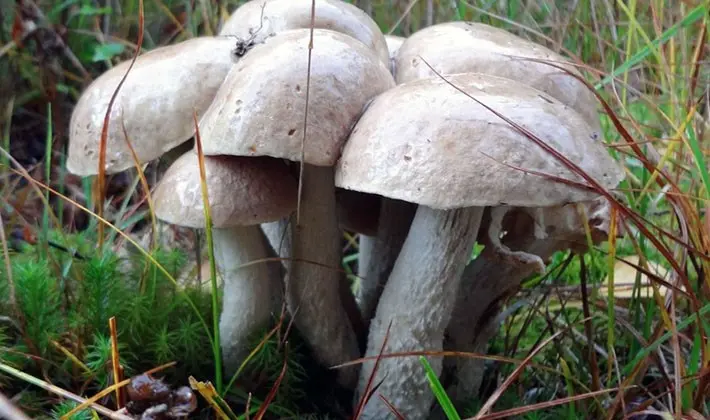
The leg is thin and long, whitish or whitish-cream, covered with gray-cream scales, which become gray-brown when dry. Height 5-15 cm, sometimes reaches 18 cm, thickness 1-2,5 cm. The second distinguishing feature of the species is the ability to quickly oxidize, which is expressed by the appearance of pinkish spots when touched.
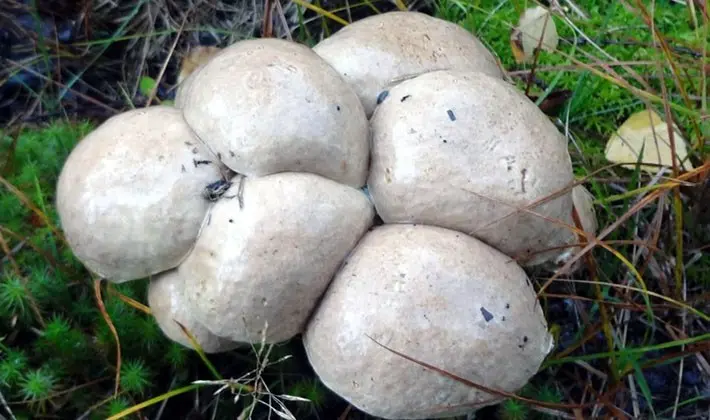
The pulp is soft, white, dense, has a slight mushroom aroma, quickly turns pink at the break. The hymenophore is whitish, becoming grayish with time.
The tubular layer 1,2-2,5 cm thick is white in young specimens and dirty grayish later, with rounded-angular pores of the tubules.
Variability: The color of the cap varies from white and light cream to pinkish cream. Tubules and pores – from white to gray. The white leg darkens with age, becoming covered with brownish-gray scales.
There are no poisonous twins, but from afar, by the color of the cap, this boletus can be confused with the deadly poisonous white form of the pale grebe (Amanita phalloides), which, upon closer examination, is sharply distinguished by the presence of a ring on the stem and a Volvo at the base.
Edible, 2th category.
Boletus, form hornbeam (Leccinum carpini).
Habitats: singly and in groups in deciduous forests.
Season: from July to the end of September.
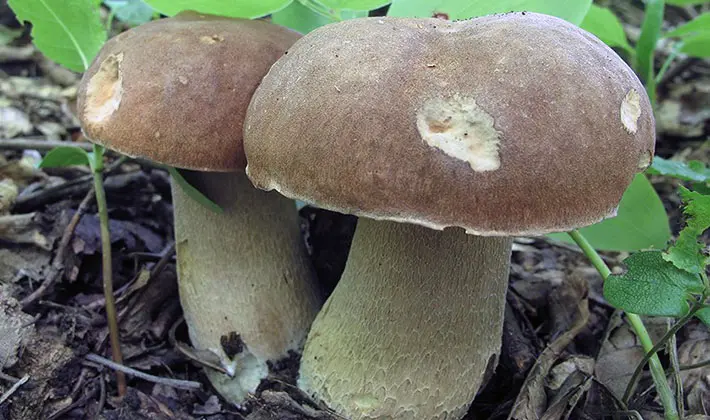
The cap is fleshy, 3-8 cm in diameter, and in some cases up to 12 cm. The shape of the cap is hemispherical, becoming less convex with age. A distinctive feature of the species is the granular surface of the cap and gray-brown color. In young specimens, the edge of the cap is bent; in mature specimens, it straightens out.
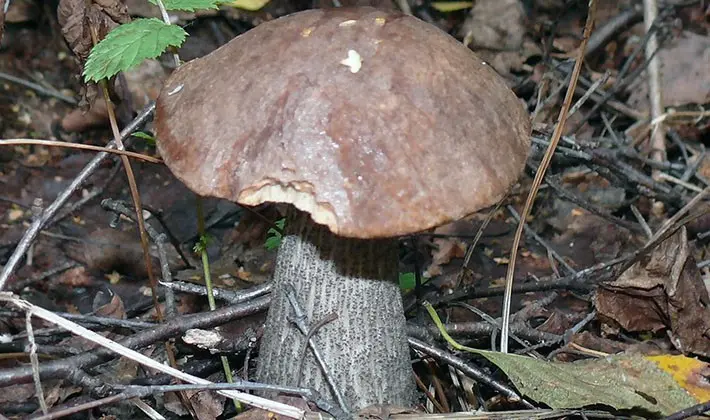
The leg is thin and long, light brown, cylindrical, covered with blackish scales, narrowed in the upper part.

The flesh at the break is painted first in pinkish-violet, then in gray and later in blackish color.
Tubular layer up to 2,5 cm thick with very fine white pores.
Variability: the color of the cap varies from gray-brown to ash-gray, ocher and even whitish. As the fungus matures, the skin of the cap may shrink, exposing the tubules surrounding it. The pores and tubules are whitish at first, then grey. The scales on the stem are whitish at first, then light yellow, and finally blackish-brown.
There are no toxic twins. Bile mushrooms (Tylopilus felleus) are a bit similar, in which the flesh has a pinkish tinge, they have an unpleasant odor and a very bitter taste.
Cooking methods: drying, marinating, canning, frying. It is recommended to remove the leg before use, and in older mushrooms – the skin.
Edible, 2th category.
Brown boletus (Leccinum brunneum).
Habitats: birch, coniferous and mixed forests.
Season: from June to October.
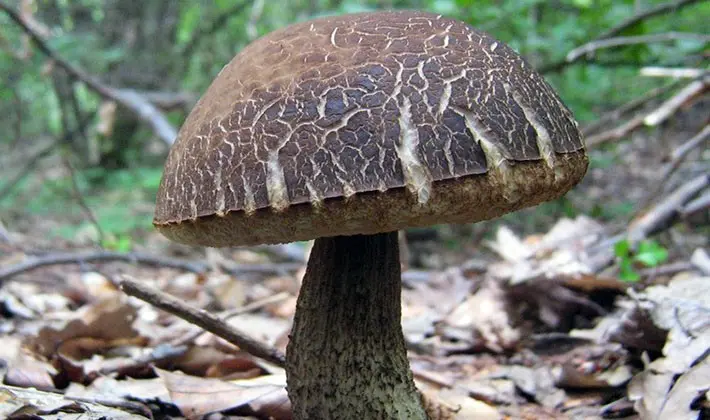
The cap is fleshy, 5-14 cm in diameter, and in some cases up to 16 cm. The shape of the cap is hemispherical with a slightly woolly surface, with age it becomes less convex. A distinctive feature of the species is a brown hat with a reddish tinge with a shiny surface. The lower surface is finely porous, the pores are cream-gray, yellow-gray.
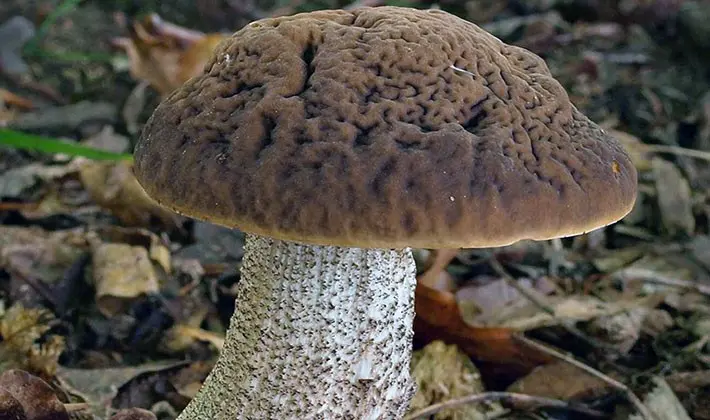
The leg is gray-cream in color, covered along the entire length with black scales, in mature specimens it is dark.
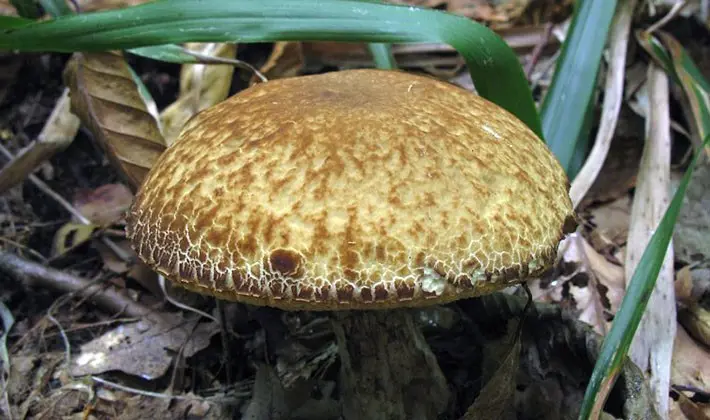
The flesh is dense whitish, on the cut it turns gray-black.
Tubular layer up to 2,5 cm thick with very fine white pores.
Variability: The color of the cap varies from brown to brown-brown. As the mushroom matures, the skin of the cap can go from sticky and shiny to drier and matte. The pores and tubules are whitish at first, then yellow-gray. The scales on the stem are gray at first, then almost black.
There are no toxic twins. Bile mushrooms (Tylopilus felleus) are a bit similar to these boletus mushrooms, in which the flesh has a pinkish tinge and they have an unpleasant odor and a very bitter taste.
Cooking methods: drying, marinating, canning, frying. It is recommended to remove the leg before use, and in older mushrooms – the skin.
Edible, 2th category.
Orange-cap boletus

Boletus and boletus do not differ in name in Latin (Leccinum). This is not accidental, since the properties of these mushrooms are close. The taste of fried boletus is slightly sweeter. In addition, cooked boletus almost always darkens, and boletus blackens much less. Among our nature lovers, aspen mushrooms are valued higher because of their beauty and taste.
Medicinal properties:
- Полный набор аминокислот.
- Many salts of iron, phosphorus and potassium.
- Rich in vitamins A, B, B1, PP.
- Aspen mushrooms perfectly cleanse the blood and lower cholesterol levels. If you take 1 teaspoon of boletus powder daily for a month, then the blood improves.
Orange-yellow boletus (Leccinum testaceoscabrum)
Habitats: deciduous, mixed and pine forests, growing singly and in groups.
Season: June – early October.

The hat is dense 4-12 cm in diameter. The shape of the cap is hemispherical, then less convex, prostrate. A distinctive feature of the species is the orange-yellow color of the cap with reddish streaks. The surface is velvety or smooth, dry, and slightly sticky in wet weather. The lower surface is finely porous, the pores are light gray or ocher gray.
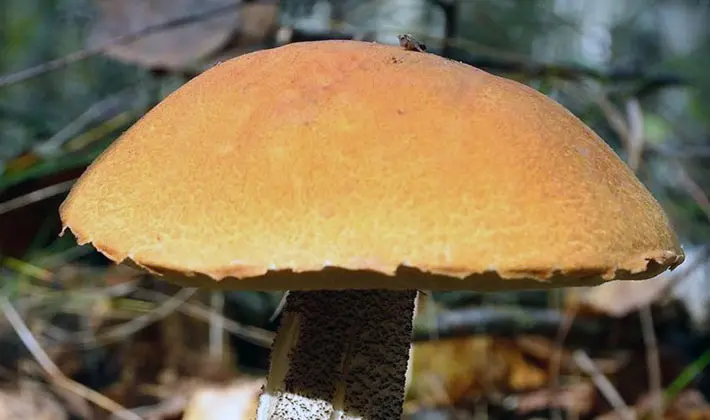
Leg 5-16 cm long. The second distinguishing property of the species is a long white cylindrical stem with white flaky scales without expansion near the base. In mature mushrooms, the scales darken slightly, the thickness of the stem is 1-2 cm.
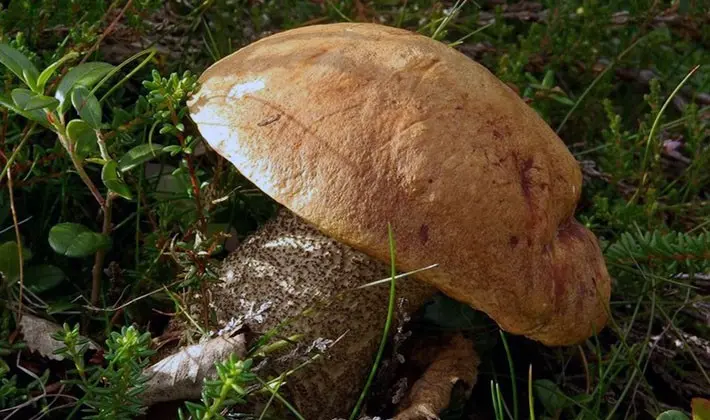
The pulp is thick, dense, white, on a break it acquires a color from lilac to gray-black.
The tubular layer is off-white or grayish with small rounded pores of the tubules. Spore powder is brown-buffy.
Variability: the cap becomes dry and velvety over time, and the color of the cap changes from yellow-orange to red. As the fungus matures, the skin of the cap may shrink, exposing the tubules surrounding it. The scales on the leg are first white, then gray.
The underside of the cap may be whitish-yellow to greyish in color.
There are no toxic twins. Boletus orange-yellow in the color of the cap is similar to an edible orange-red porcini mushroom (Boletus edulis, f. auranti – oruber), which is distinguished by a thick club-shaped stalk and the presence of a reddish net pattern on the stalk.
Cooking methods: dried, canned, stewed, fried.
Edible, 2th category.
Podosinovik bely (Leccinum percandidum).
Habitats: the mushroom is listed in the Red Book of the Federation and regional Red Books. Status – 3R (rare species). Mushrooms grow in small clearings, where there are a lot of ferns on the border of deciduous and mixed forest growth.
Season: end of June – end of September.

The cap is fleshy, 5-12 cm in diameter, and sometimes up to 20 cm. The shape of the cap is hemispherical. A distinctive feature of the species is the internal shape – it, “like a hat”, has an internal volume (concave) compared to other large boletus and boletus, where the underside of the cap is almost even. The second distinguishing feature is the color of the cap – cream, “ivory”, light brown, in old mushrooms the cap becomes yellowish, sometimes brown spots appear. Often the skin hangs over the edge of the cap.
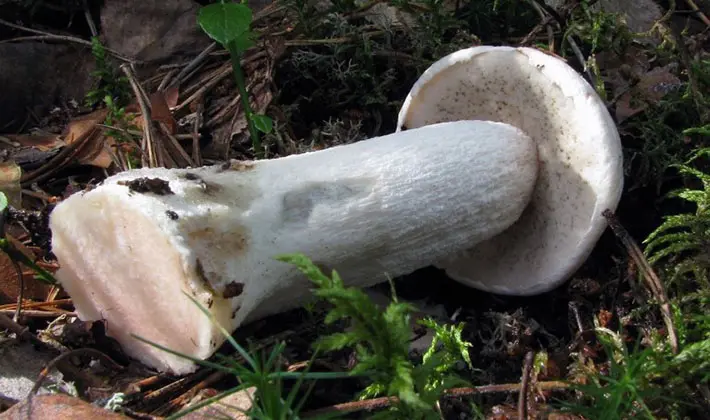
Leg 6-15 cm, thin and long, cylindrical, slightly thickened base. Young mushrooms have a stronger thickening from below. The leg is white with scales, which are almost black in mature mushrooms, 1-2,5 cm thick.

Мякоть плотная, белая, окрашивающаяся на разрезе, в основании ножки — желтоватая или светло-кремовая, а у старых грибов — с бурыми пятнами или просто бурая. Мякоть на срезе ножки синеет.
Variability: the color of the cap varies from light cream to yellowish brown. As the fungus matures, the skin of the cap may shrink, exposing the tubules surrounding it. The scales on the stem are first gray, then black.
Ядовитых двойников нет. Подосиновик белый похож по цвету шляпки на съедобный подберезовик болотный (Leccinum holopus). Подосиновик отличается внутренней формой шляпки — она вогнута по сравнению с прямой или же, наоборот, слегка свисающей подпушкой у подберезовика.
Cooking methods. Although the mushroom has good taste, but due to its rarity and inclusion in the Red Book, one should refrain from collecting it and, conversely, encourage its reproduction in every possible way. Do not tear these mushrooms, as this can carry away thousands of spores.
Edible, 2th category.
Boletus burgundy red (Leccinum quercinum).
Habitats: a rare species, grows singly in deciduous forests mixed with spruce, not far from swamps.
Season: June – September.

The hat is dense, 4-10 cm in diameter, sometimes up to 15 cm. The shape of the hat is hemispherical, similar to a helmet. A distinctive feature of the species is the burgundy-red color of the cap with a finely rough, velvety surface. The lower surface is finely porous, the pores are light gray or ocher gray.
Leg 5-16 cm long. The second distinctive feature of the species is a cylindrical leg of reddish or reddish-brown color with black spots.

The flesh is thick, dense, white-cream, on the break it becomes lilac to gray-black.
The tubular layer is white-cream or grayish with small rounded pores of the tubules. Spore powder is brown-buffy.
Variability: the hat becomes dry and velvety with time, and the color of the hat changes from burgundy-red to burgundy. As the fungus matures, the skin of the cap may shrink, exposing the tubules surrounding it. The underside of the cap can be whitish-cream to yellowish-gray.
There are no toxic twins. The boletus burgundy-red in the color of the cap is similar to an edible orange-red porcini mushroom (Boletus edulis, f. auranti – oruber), which is distinguished by a thick club-shaped stalk and the presence of a reddish mesh pattern on the stalk.
Cooking methods: dried, canned, stewed, fried.
Edible, 2th category.
Red boletus, or redhead (Leccinum aurantiacum).
Habitats: deciduous, mixed and pine forests, growing singly and in groups.
Season: июнь — конец сентября.
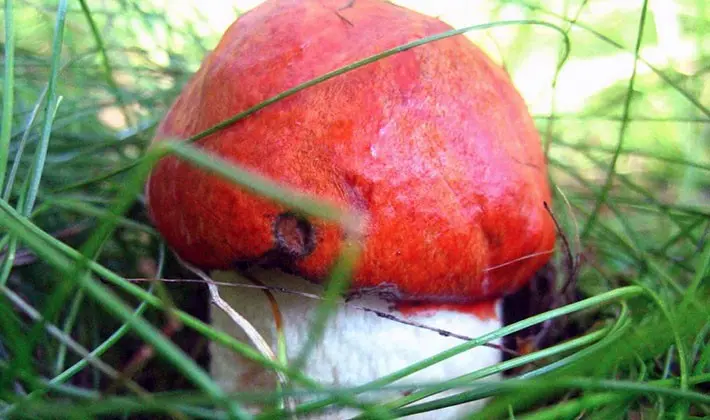
The hat is dense, 5-20 cm in diameter, and sometimes up to 25 cm. The shape of the hat is hemispherical, then less convex, prostrate. Hat color – orange, rusty red, orange-red. The surface is velvety or smooth, dry, and slightly sticky in wet weather. The lower surface is finely porous, the pores are light gray or ocher gray.
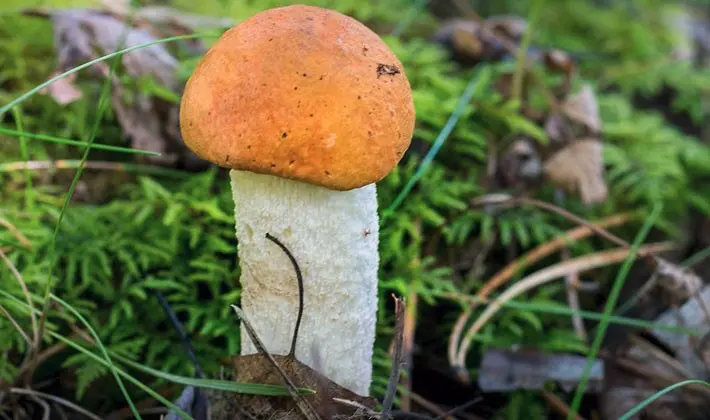
Leg 5-16 cm long, sometimes up to 28 cm, long, cylindrical, sometimes widening towards the base, often curved grayish-white with light flaky scales. In mature mushrooms, the scales darken and become almost black, the thickness of the stem is 1,5-5 cm.
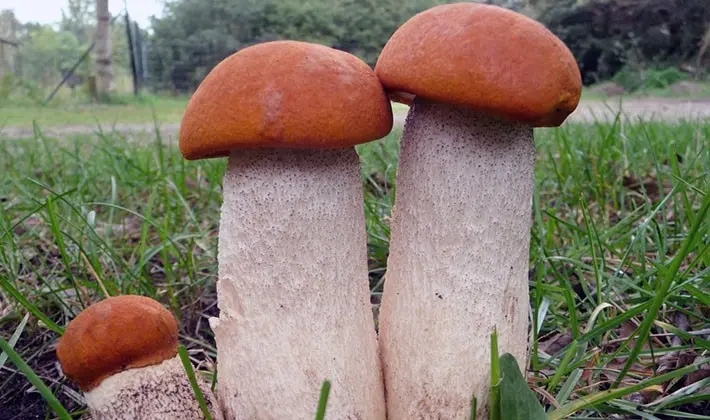
The flesh is thick, dense, white, on the break it turns from lilac to gray-black, in the lower part of the stem to a faint green-blue color.
The tubular layer is off-white or grayish with small rounded pores of the tubules. Spore powder – brown-ocherous, ocher-brown.
Variability: the cap becomes dry and velvety over time, and the color of the cap changes from yellow-orange to bright red. As the fungus matures, the skin of the cap may shrink, exposing the tubules surrounding it. The scales on the stem are first gray, then black. The underside of the cap can be whitish-yellow to greyish in color.
There are no toxic twins. Boletus red in the color of the cap is similar to the edible white pine mushroom (Boletus edulis, f. pinicola), which is distinguished by a thicker club-shaped leg and the presence of a pattern on the leg with streaks or stripes.
Cooking methods: dried, canned, stewed, fried.
Edible, 2th category.
Boletus yellow-brown (Leccinum versipelle – testaceoscabrum).
Habitats: birch, pine and mixed forests.
Season: end of June – end of September.
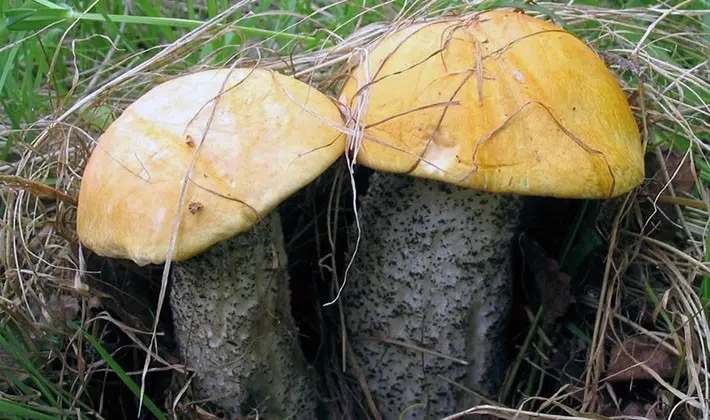
The hat is dense, 5-16 cm in diameter, and sometimes up to 20 cm. The shape of the hat is hemispherical, convex. A distinctive feature of the species is the color of the cap – yellow-brown, yellow-orange, bright orange, reddish-brown. The surface is velvety or smooth, dry, and slightly sticky in wet weather.
The skin often hangs over the edge of the cap. The lower surface is finely porous, the pores are light gray or ocher gray.
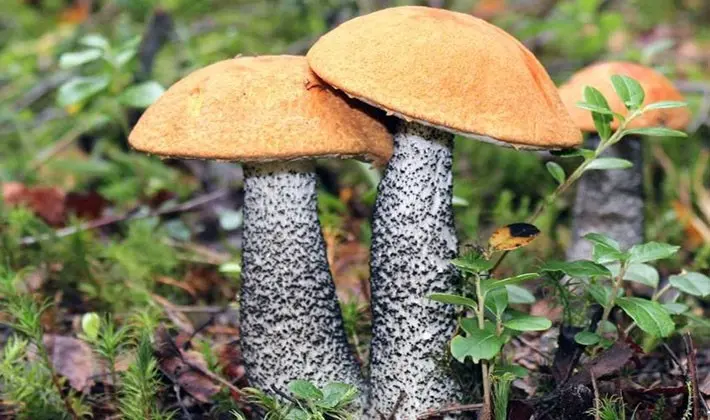
Leg 5-10 cm long, thick and long, club-shaped, tapering upwards. In young mushrooms, the stem is strongly thickened. The leg is white with gray scales, which are almost black in mature mushrooms, 2-5 cm thick.

The flesh is dense white, slightly pinkish at the break, then gray and then becomes pinkish-purple or dirty gray, and blue-green on the stem.
Tubules 0,7-3 cm long with small rounded pores. The section shows serrated off-white tubules. The surface of the tubular layer in young mushrooms is gray, then gray-brown. Spore powder – olive brown
Variability: the color of the cap varies from yellow-brown to bright orange. As the fungus matures, the skin of the cap may shrink, exposing the tubules surrounding it. The scales on the stem are first gray, then black.
There are no toxic twins. Inedible bile mushrooms (Tylopilus felleus) are a bit similar, in which the flesh with a pinkish tinge is very bitter.
Cooking methods: dried, canned, stewed, fried.
Edible, 2th category.
Flywheels and goats
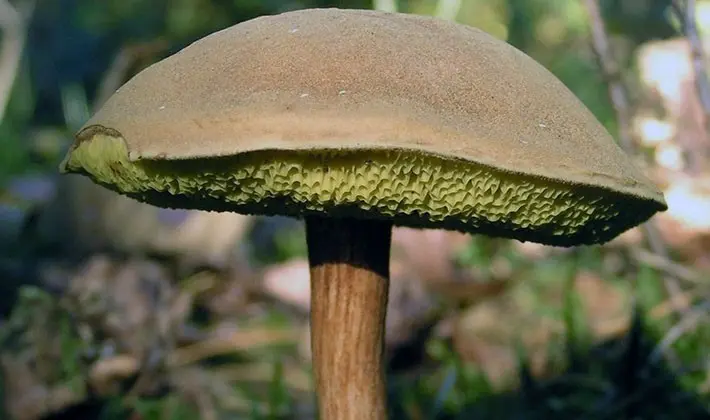
July flywheels and goats often grow in mixed forests with oaks and spruces. They are often inconspicuous and hide well in foliage and fallen leaves.
Flywheel yellow-brown (Suillus variegates).
Habitats: grows in pine and mixed forests, singly or in groups. The property of accumulation of harmful substances: this species has the property of a strong accumulation of heavy metals, so you should strictly observe the condition of collecting mushrooms in an area no closer than 500 meters from highways and chemical enterprises.
Season: July – October.
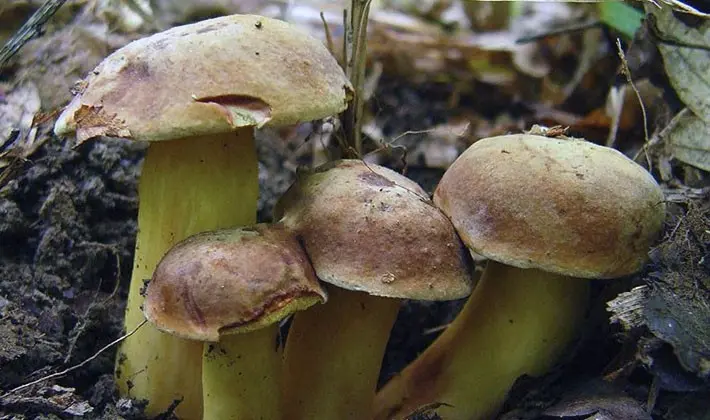
The hat is 4-12 cm in diameter, cushion-like, convex, with a bent, and with age with a lowered edge, lemon-yellow, yellow-brown or olive-ocher. The skin on the hat is dry, fine-grained or almost felt, becoming smoother with time, after rain a little slippery.
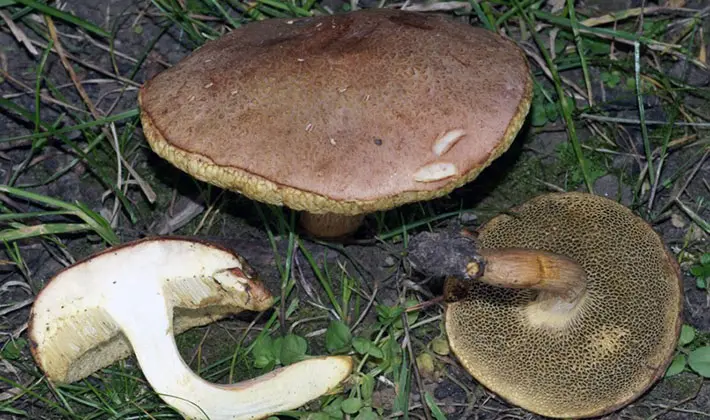
The leg is cylindrical, yellowish, with a dark marble pattern, 5-8 cm high, 1,5-2,5 cm thick.

The pulp is yellow, has no smell and taste, slightly turns blue on the cut.
The tubules are olive in youth, then rusty olive.
Variability: the cap becomes dry and velvety over time, and the color of the cap changes from chestnut to dark brown. The color of the stem varies from light brown and yellow-brown to reddish-brown.
Similar types. The Polish mushroom (Boletus badius) is similar, but it does not have a velvety, but a leathery and oily cap surface.
There are no toxic twins. Bile mushrooms (Tylopilus felleus) are a bit similar, in which the flesh has a pinkish tint, and the hat is brown, they are very bitter.
Cooking methods: drying, marinating, boiling.
Edible, 3th category.
Motley moth (Boletus chrysenteron).
Habitats: grows in deciduous and mixed forests, along the edge of roads, ditches, along the edges. Mushrooms are rare, listed in some regional Red Books, where they have the status of 4R.
Season: July – October.
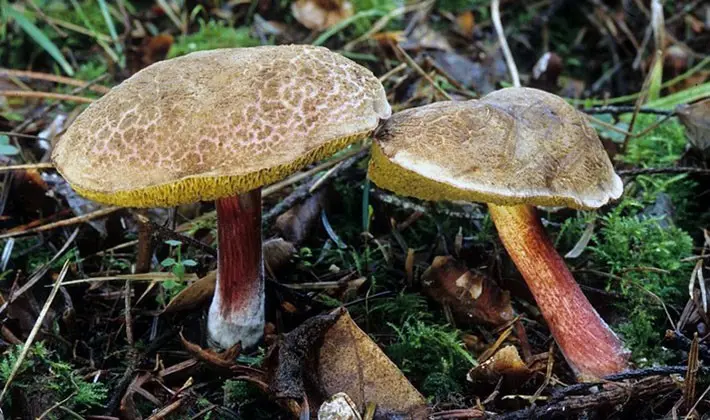
Шляпка диаметром 4-8 см, иногда до 10 см, полусферическая Отличительным свойством вида является сухая, матовая, бархатистая, сетчато-растрескивающаяся, коричнево-бурая, красновато-коричневая шляпка. Трещины часто имеют розовый оттенок.

The leg is cylindrical, 3-8 cm high, 0,8-2 cm thick, light yellow, reddish in the lower part. The foot at the base may taper. The leg is often curved, has small reddish scales.
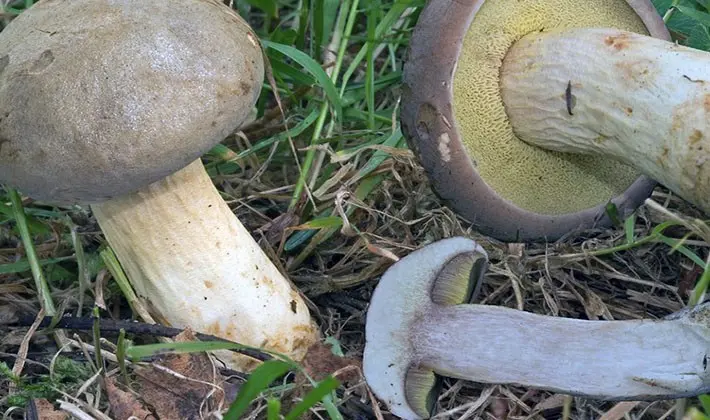
The flesh is dense, whitish or yellowish, reddish under the skin of the cap and at the base of the stem, slightly bluish at the break.
The tubules are olive in youth, then rusty olive. Spores are olive brown.
The hymenophore is adherent, easily separated from the pulp, consists of tubules 0,4-1,2 cm long, cream-yellow, yellowish-green, later olive in color, turning green at the break. The pores of the tubules are large. Spore powder is yellow-olive-brown.
Variability. The view itself is variable. There are light specimens ocher-gray, almost red and brown, yellowish-cream. There are darker reddish-brown and even brown. As the fungus matures, the skin of the cap may shrink, exposing the tubules surrounding it.
There are no toxic twins. Bile mushrooms (Tylopilus felleus) are a bit similar, in which the flesh has a pinkish tint, and the hat is brown, they are very bitter.
Cooking methods: drying, marinating, boiling.
Edible, 3th category.
Goat (Suillus bovines).
Habitats: grows in damp pine or mixed forests and sphagnum bogs.
Season: July – October.
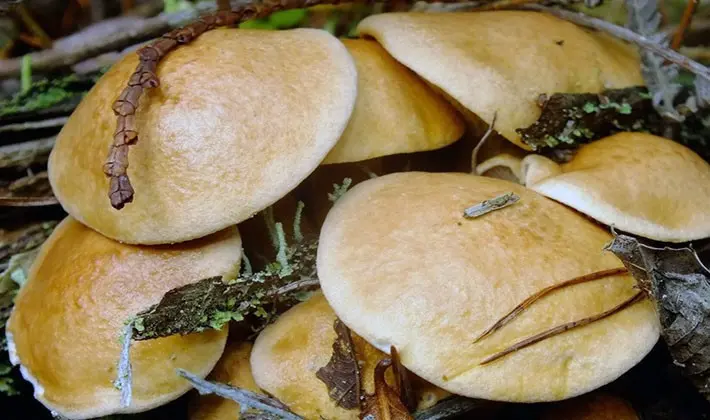
Hat with a diameter of 2-8 cm, but sometimes up to 10 cm, hemispherical, yellow-brown or reddish, dry with a dense yellow down. The film does not separate from the cap. Over time, the shape of the hat flattens. The surface is oily in wet weather.
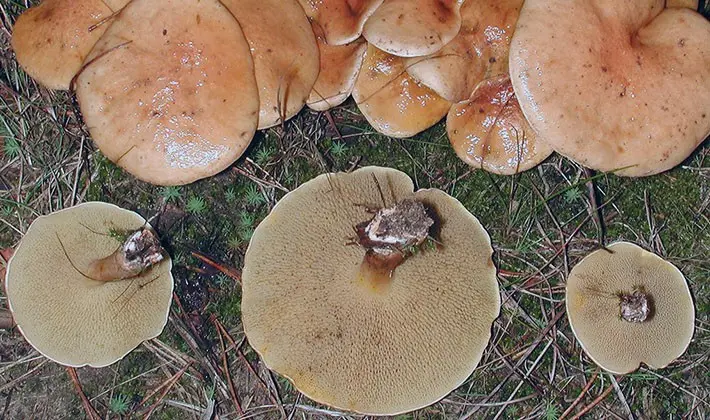
Leg thin, yellow, 3-8 cm tall, 0,6-2 cm thick, slightly narrowed below. The color of the stem is more or less uniform, the color is from yellow-brick to reddish.
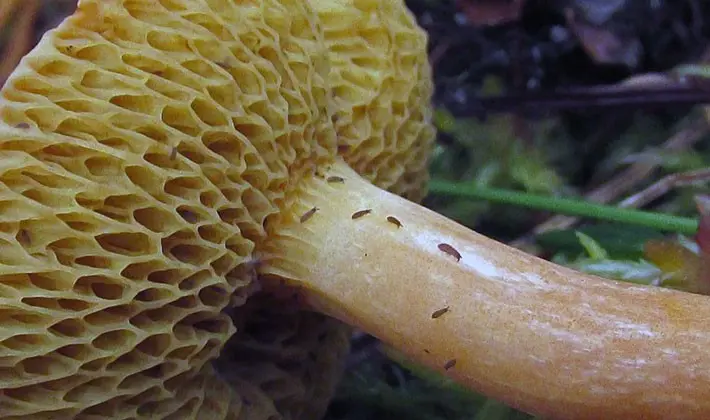
The flesh is soft pinkish, brownish-creamy, whitish-yellowish, slightly reddening when cut. The pulp has no odor.
The pores of the tubular layer are clearly visible. The tubules are adherent, descending, 0,3-1 cm high, yellow or olive-yellow in color with large angular pores of olive-green color.
The hymenophore is adherent, easily separated from the pulp, consists of tubules 0,4-1,2 cm long, cream-yellow, sulfur-yellowish-green, later olive in color, turning green at the break. The pores of the tubules are large and angular. Spore powder is yellow-olive-brown.
Изменчивость. Цвет может быть от желто-коричневого до бурого и ржаво-коричневого. Цвет ножки — от светло-оранжевого до темно-кирпичного.
There are no toxic twins. Bile mushrooms (Tylopilus felleus) are a bit similar, in which the flesh has a pinkish tint, and the hat is brown, they are very bitter.
Cooking methods: drying, marinating, boiling.
Edible, 3th category.
Russula

Russula mushrooms in July capture more and more forest areas. Especially a lot of them grows on forest, spruce litter, although some species prefer damp places.
Russula betularm (Russula betularm).
Habitats: in damp deciduous or mixed forests, near birches.
Season: June – October.
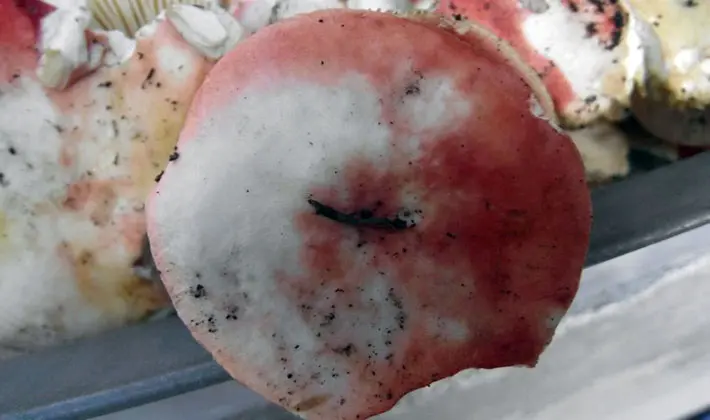
The cap has a diameter of 3-8 cm, sometimes up to 10 cm. The shape is first convex hemispherical, later flat-depressed. A distinctive feature of the species is a depressed hat with a reddish-pink middle and light pink edges. The skin is smooth, shiny, sometimes covered with small cracks.

Leg: 4-10 см длиной, 7-15 мм толщиной. Форма ножки — цилиндрическая или немного, белого цвета, ломкая. У старых грибов ножка становится сероватой.
The plates are frequent, wide, with slightly serrated edges. The color of the plates is first white, then white-cream.
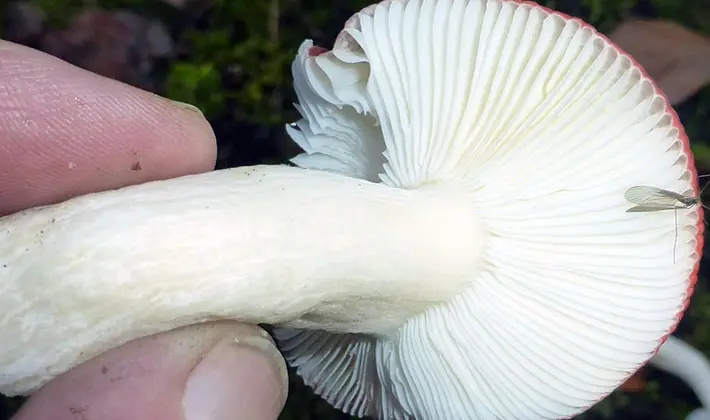
The pulp is white, fragile, tastes sweetish.
Spores are light buffy. Spore powder is pale yellow.
Variability. In young mushrooms, the edges of the cap are smooth, with age they become ribbed. The cap margins of young mushrooms may be completely white or with a slight pink tint, later pink. The middle is pink at first, later red-pink.
similarity with other species. Russula birch is similar to the edible marsh russula (Russula paludosa), in which, on the contrary, the middle is lighter, yellowish, and the edges are darker, reddish. Russula birch can be confused with burning vomit (Russula emitica), which have a white stem and a sharp peppery taste, a burning red cap and no other color in the center.
Cooking methods: marinating, cooking, salting, grilling.
Edible, 3th category.
Russula fading (Russula decolorans).
Habitats: coniferous, often pine forests, in moss and blueberries, grow in groups or singly.
Season: July – September.
The cap is 4-10 cm in diameter, sometimes up to 15 cm, at first spherical, hemispherical, later flat-convex, prostrate, to depressed with blunt smooth or ribbed edges. Colour: tan, reddish orange, brick orange, yellowish orange. The hat fades unevenly over time, forming spots with a reddish and dirty gray color. The skin of young mushrooms is sticky, then dry and smooth.
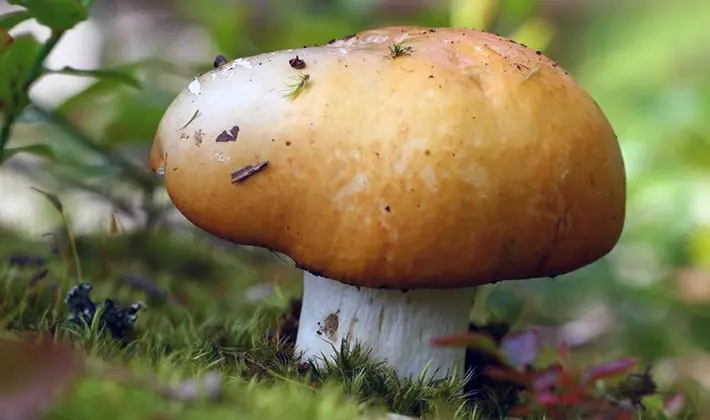
Leg 5-10 cm tall, 1-2 cm thick, cylindrical, sometimes narrowed towards the base, dense, whitish, then gray or yellowish.
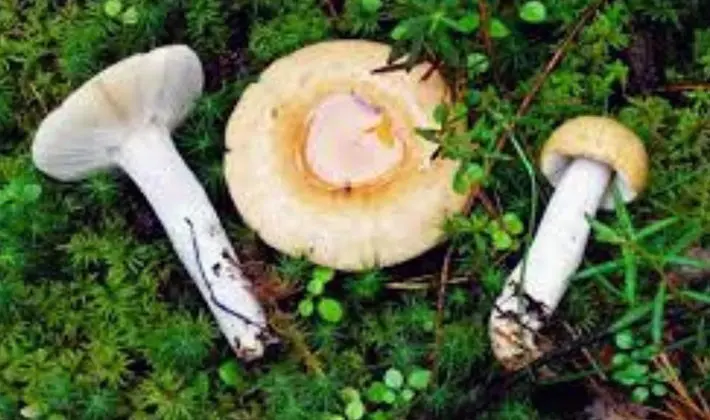
Мякоть белая, хрупкая со сладковатым вкусом, немного острая, на разломе сереет.
Records of medium frequency, thin, wide, adherent, white with a yellow or gray tint, and even later – dirty gray.
Variability. Cap colors and fading are variable: brownish, reddish, rusty brown, and even greenish.
similarity with other species. The fading russula is a bit like the burning russula (Russula emitica), in which the plates are white, the flesh does not turn gray and has a pungent taste, the color of the cap is red-brown.
Cooking methods: fry, marinate,
Edible, 3th category.
Russula bile (Russula fellea).
Habitats: in spruce and deciduous forests, grows either in groups or singly.
Season: July – September.
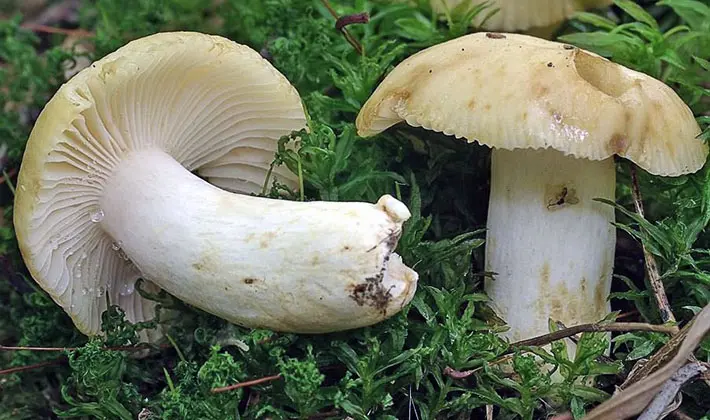
Cap 4-9 cm in diameter, at first hemispherical, convex, later convex-prostrate or flat, slightly depressed in the middle, smooth, dry, with blunt, smooth edges. A distinctive feature of the species is a straw-yellow color with a yellow or slightly brownish middle and reddish-yellow edges.
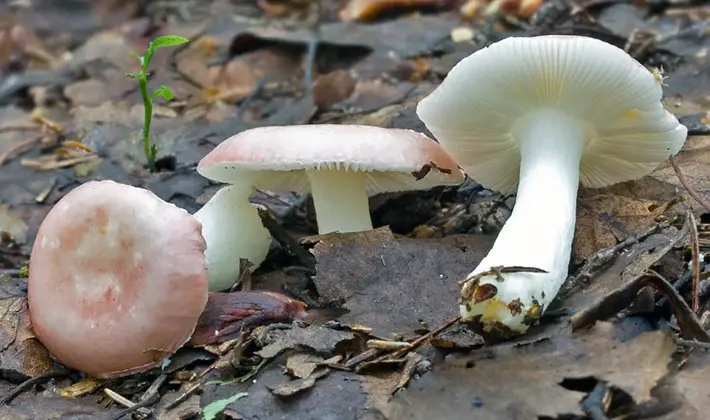
Leg 4-7 cm high, 8-15 mm thick, cylindrical, even, dense, white. The color of the stem with age becomes the same straw-yellow as that of the cap.
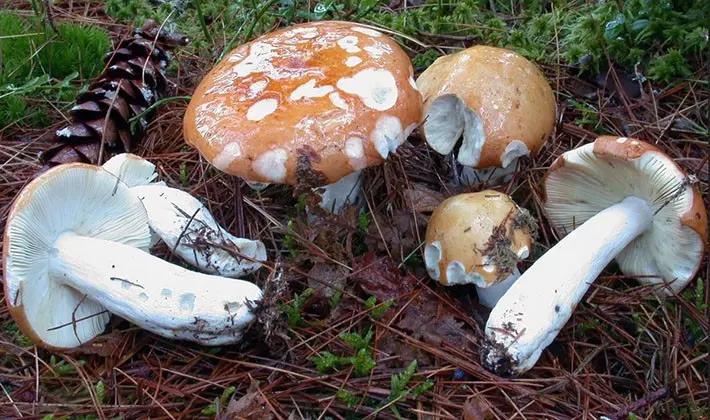
Pulp. The second distinguishing property of the species is the honey smell of the pulp and the burning, caustic and bitter taste.
The plates are whitish, later almost the same color as the cap. Many plates are branched. Spores are white.
Variability. The straw yellow color fades over time and the color of the cap becomes light yellow in the middle and slightly brighter at the edges.
similarity with other species. The bilious and conditionally edible russula can be confused with the good, tasty yellow russula (Russula claroflava), which has a bright yellow or lemon yellow cap, but no pulpy smell.
They have a bitter taste, but when boiled in 2-3 waters, the bitterness decreases, spicy sauces can be prepared.
Edible conditionally because of the spicy and bitter taste.
Russula green (Russula aeruginea).
Habitats: in coniferous and deciduous forests, mainly under birches.
Season: June – October.
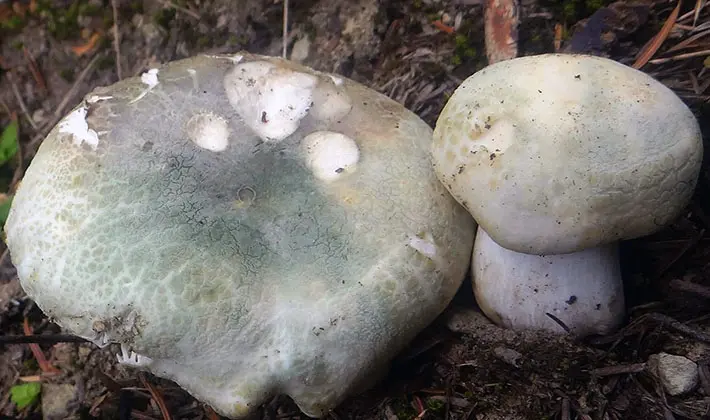
Cap 5-9 cm in diameter, sometimes up to 15 cm, at first hemispherical, convex, later convex-prostrate or flat, depressed with smooth or slightly ribbed edges. The color may be lighter at the edges. A distinctive feature of the species is the greenish color of the cap with a darker color in the center. In addition, there are rusty or red-yellow spots in the center of the cap. The skin is sticky in wet weather, covered with thin radial grooves.

Ножка 4-9 см высотой, 8-20 мм толщиной, цилиндрическая, ровная, плотная, гладкая, блестящая, белая или с ржаво-коричневыми крапинками. У основания ножка может слегка суживаться. Ножка сереет на срезе.

The flesh is firm, brittle, odorless and with a peppery or pungent taste.
The plates are frequent, bifurcated, free or adherent, slightly descending along the stem, white or cream.
Variability. Over time, only the shade changes against the background of the general green color.
Similarity to other edible species. The green russula can be confused with the greenish russula (Russula virescens), in which the hat is not pure green, but yellow-green, and the stem is white with brownish scales at the base. Both types are edible.
The difference from the poisonous green form of the pale grebe (Amanita phallioides): the green russula has a flat base of the leg, while the pale grebe has a ring on the leg and a swollen vagina at the base.
Способы приготовления: маринование, жарка, соление.
Edible, 3th category.
Russula luteotacta, or whitish (Russula luteotacta).
Habitats: mixed forests.
Season: July – September.
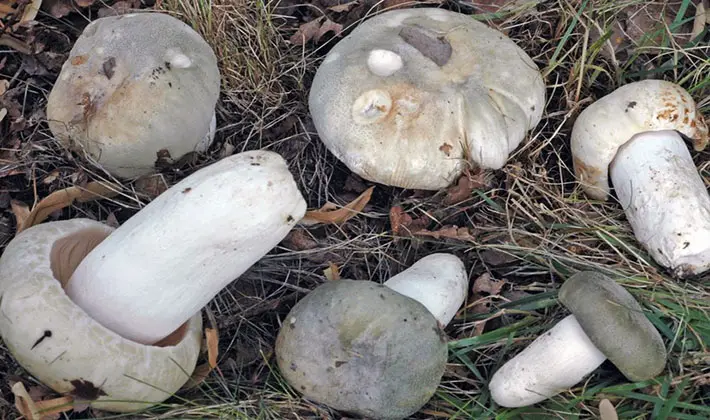
The cap is 4-8 cm in diameter, sometimes up to 10 cm, at first hemispherical, later convex and prostrate, depressed in the middle. A distinctive feature of the species is a whitish hat with a yellowish-brown center. The edges of the cap in mature specimens are uneven, furrowed.
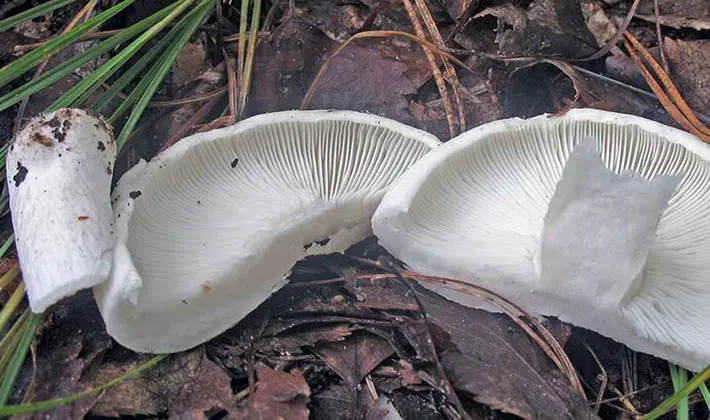
Leg 4-9 cm high and 7-20 mm thick, white, cylindrical, slightly expanding downwards, at first dense, later hollow.
The pulp is white, brittle with a weak, slightly bitter taste.
The plates are frequent, white or white-cream in color. Spores are white.
Variability. The color of the cap varies from pure white to yellowish with a center dominated by yellow and brown tones.
similarity with other species. This russula can be confused with the conditionally edible russula (Russala farinipes), which has an ocher-yellowish cap.
The difference from the poisonous white form of the pale grebe (Amanita phallioides) lies in the presence of a ring on the leg and a swollen volva at the base in the pale grebe.
Conditionally edible due to bitter taste.
Russula ocher-yellow (Russula ochroleuca).
Habitats: coniferous and deciduous forests, grow in groups and singly.
Season: July – September.
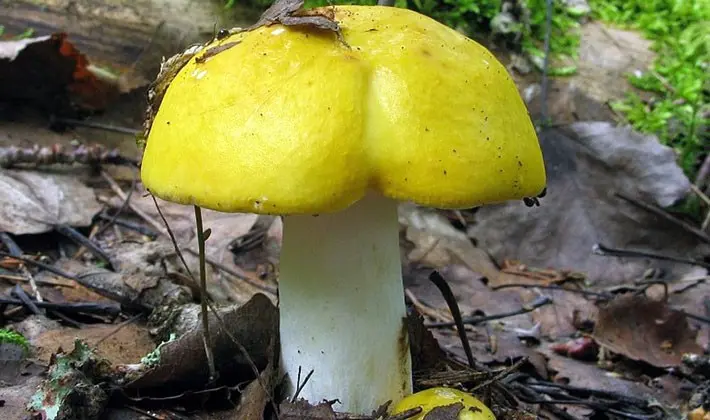
The cap is 4-10 cm in diameter, at first hemispherical, later convex and prostrate, depressed in the middle. The surface is matte, dry, becomes sticky in wet weather. A distinctive feature of the species is an ocher-yellow color, sometimes with a greenish tint. The center of the cap may be darker, brownish silt and reddish-yellowish. The skin is easily removed.
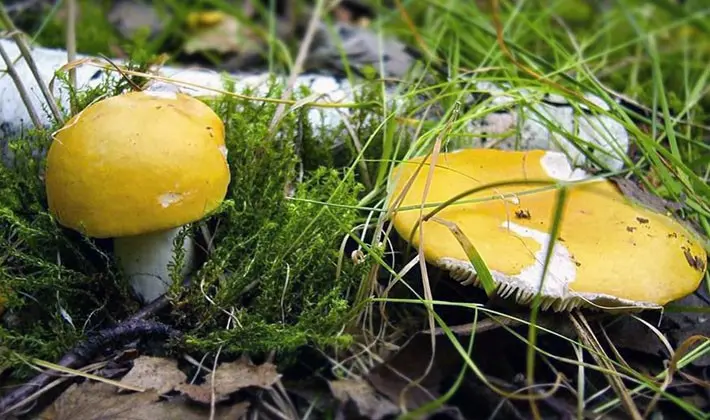
Leg 4-9 cm high and 1-2 cm thick, smooth, cylindrical, white at first, later grayish-yellow.
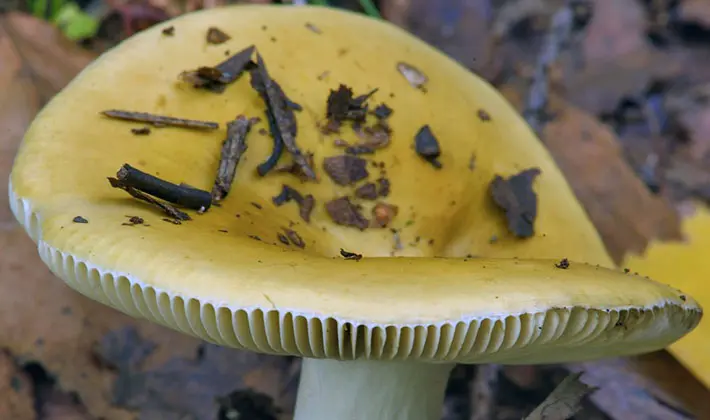
The pulp is fragile, whitish, with a sharp taste.
The plates are thick, adherent, white or light cream.
Variability. The white cylindrical stem turns gray with age.
Similarity to other edible species. The ocher-yellow russula can be confused with the edible yellow russula (Russula claroflava), which has a bright yellow cap and white flesh that slowly turns black when cut.
The difference from the poisonous pale grebe (Amanita phallioides) with a variety with an olive or yellowish cap is that the pale grebe has a ring on the leg and a swollen volva at the base.
Conditionally edible due to peppery taste. Suitable for cooking hot spices. The sharpness decreases when boiled in 2-3 waters.
Russula purple-reddish (Russula obscura).
Habitats: swampy coniferous and deciduous forests, growing in groups or singly.
Season: July – September.
Medicinal properties:
- Russula purple-reddish has antibiotic properties against pathogens of various diseases – staphylococci and against harmful bacteria – pullularia. Tinctures based on these mushrooms have antibacterial properties and can suppress the reproduction of staphylococci.
- Purple-red dyes are active against harmful bacteria. This allows for a stronger antibacterial effect.
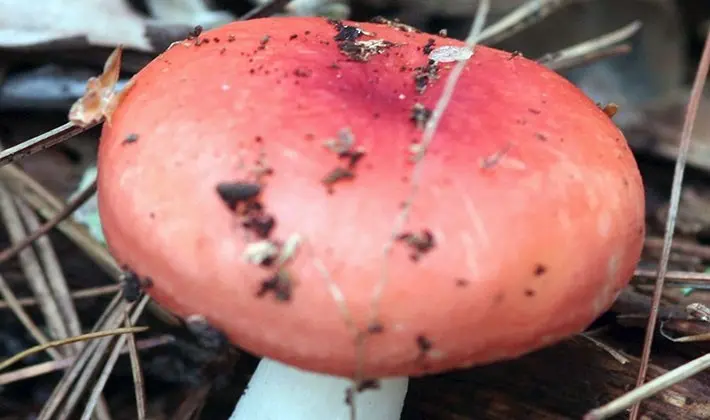
The cap is 4-15 cm in diameter, at first hemispherical, later prostrate, depressed in the middle, with a wavy, sometimes serrated edge. The surface is slightly sticky in wet weather, dry in other weather. A distinctive feature of the species is the main purple-reddish color and variations are possible: reddish-bluish, brownish-red with a gray tint. In young mushrooms, the central part of the cap is darker, but later it fades to a yellowish-brown hue.

Ножка 4-10 см высотой и 1-2,5 см толщиной, цилиндрическая, плотная, к основанию немного суженная, со временем становится рыхлой.
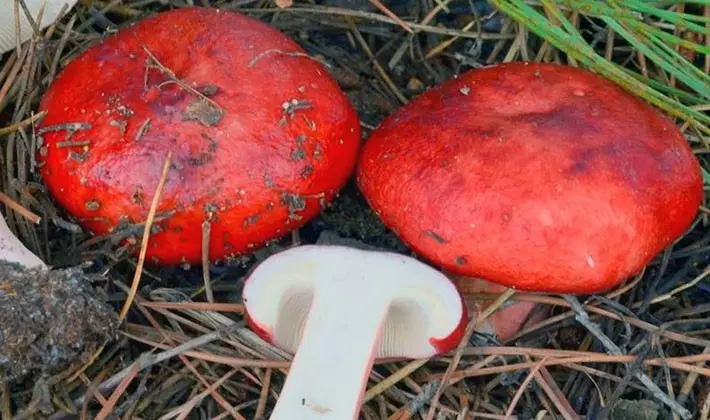
The flesh is white, graying on the break, with a pleasant mild non-caustic taste.
The plates are 0,7-1,2 cm wide, white in young specimens, later with a yellowish tinge, creamy spore powder.
Variability. The color of the cap is variable: from purple-reddish to brownish-red to brick-brown.
similarity with other species. The purplish-reddish russula can be confused with the inedible pungent russula (Russula emitica), which has a red, pink-red or purple cap, a pinkish stem in places, white flesh, pinkish under the skin, with a very burning taste.
Ways of using: marinating, salting, hot.
Russula pink (Russula rosea).
Habitats: deciduous and pine forests, in groups or singly.
Season: August – October.
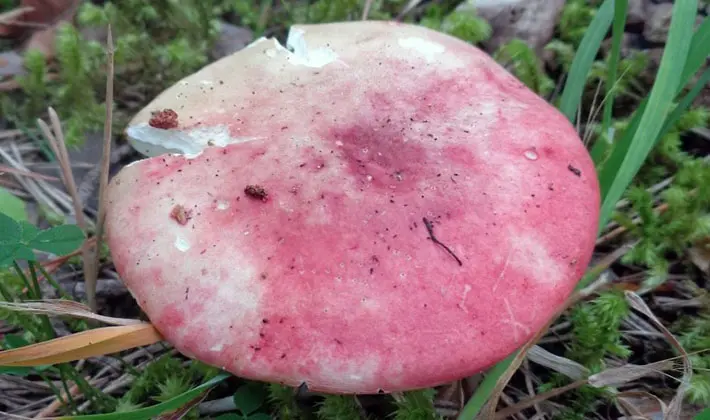
The hat is 4-10 cm in diameter, at first hemispherical, later prostrate, concave in the middle, dry with a smooth thick edge. The surface is slightly sticky in wet weather, dry in other weather. A distinctive feature of the species is pink, rose-red, pale red color with blurry whitish and yellowish spots. The skin is not removed.
Leg 4-8 cm tall, 1-2,5 cm thick, short, white at first, then pinkish, fibrous, cylindrical.

The pulp is dense, brittle, whitish in color, bitter in young mushrooms, sweet in mature ones.
The plates are thin, medium frequency, narrow, white at first, later cream or pinkish-cream. The plates are either narrowly adherent or free.
Variability. The color of the cap is variable: from pink-red to yellow-pink.
similarity with other species. The pink russula is similar to the edible marsh russula (Russula paludosa), which has an orange-red hat, a slightly club-shaped stem, white with a pink tint. The pulp of the marsh russula does not have a bitter taste, but a pleasant mushroom one.
A conditionally edible mushroom due to its bitter taste, it is used for making hot spices. Bitter taste can be mitigated by
Russula purple, or lilac (Russula violaceae).
Habitats: pine, spruce and mixed forests, grow in groups or singly.
Season: July – October.
The hat is 4-10 cm in diameter, sometimes up to 12 cm, at first convex, hemispherical, then prostrate, almost flat with a concave middle. A distinctive feature of the species is a purple hat with uneven, wavy edges and a darker shade in the middle. In addition, the edges of the cap hang down.
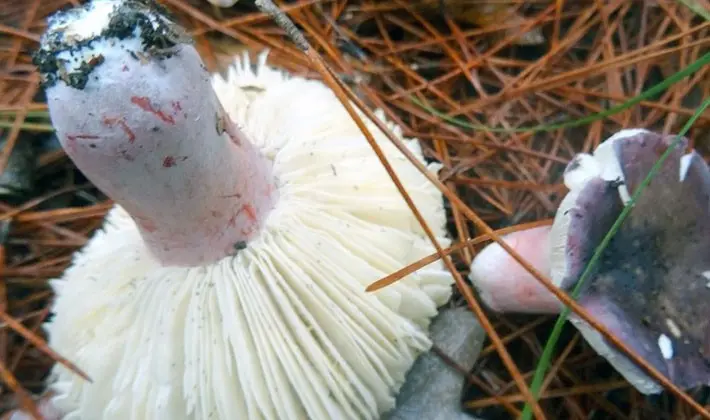
The leg has a length of 5-10 cm, a thickness of 7-15 mm, it is white, cylindrical in shape.
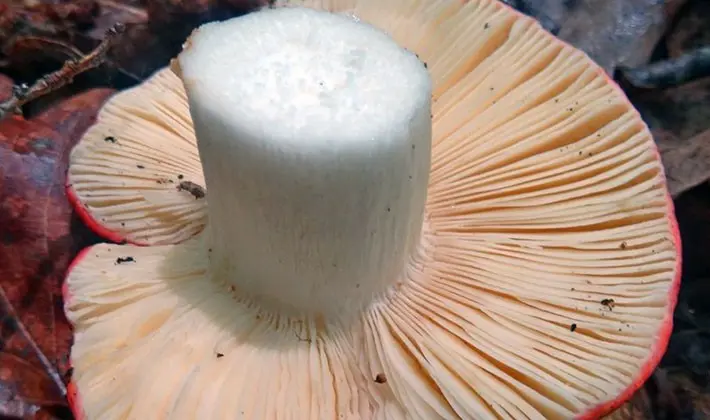
The pulp is brittle, white.
The plates are frequent, adherent, at first white, and as they mature, cream.
Variability. The color of the cap varies from purple to lilac and brown-violet.
Similarity to other edible species. Russula purple can be confused with the purple form of brittle russula (Russula fragilis, f. violascens), which is distinguished by the presence of chips and a brittle hat, as well as a light purple color.
Cooking methods: pickling, salting, frying. Mushrooms are listed in the regional Red Books, status – 3R.
Edible, 4th category.
Value
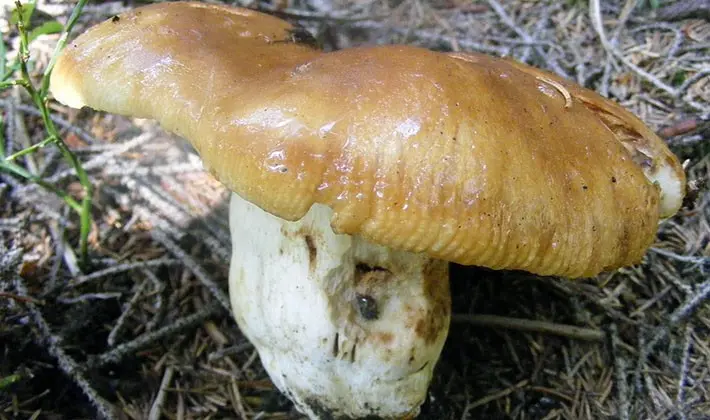
Валуи в июле растут повсеместно, предпочитая высокие места. В деревнях и местах с давними традициями валуи собирают помногу, вымачивают и засаливают в бочках. В окрестностях больших городов их также очень много. Но здесь их почти не собирают, отдавая предпочтение другим видам. Они отличаются многообразием форм и размеров: от шарообразной на ножке до зонтикообразных.
Valui (Russula foetens).
Habitats: mixed with birch and coniferous forests, grow in groups.
Season: July – September.
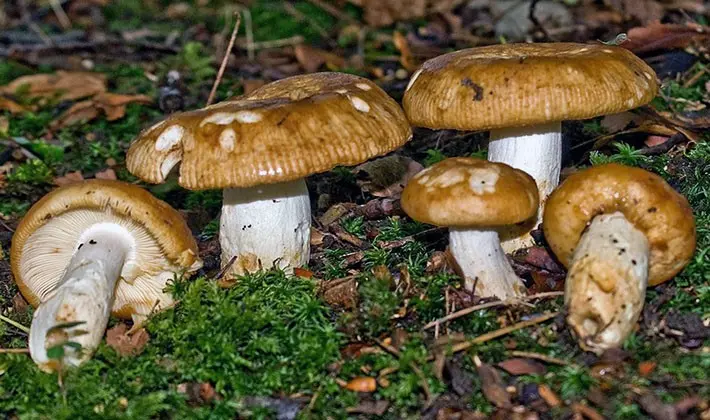
The hat is 3-15 cm in diameter, sometimes up to 18 cm, fleshy, at first spherical and hemispherical, then prostrate flat, often with a small depression in the middle, slimy, sticky, with a ribbed edge, sometimes cracking. A distinctive feature of the species is the spherical shape in young specimens and the color of the cap: ocher, straw, dirty yellow, orange-brown. The skin is not removed.
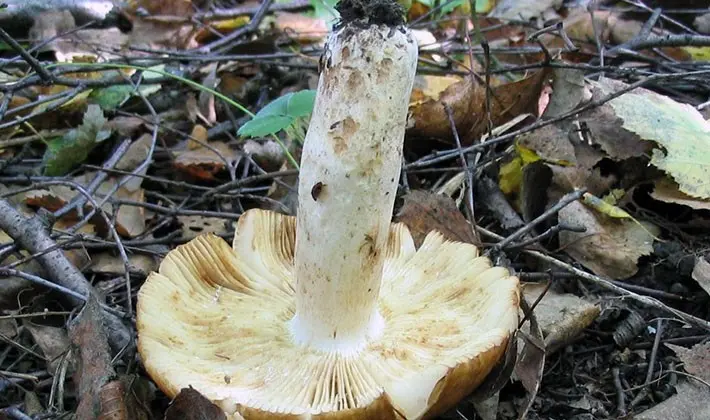
Leg 3-8 cm high, 1-2,5 cm thick, cylindrical, sometimes swollen in the middle, at first spongy, of the same color with a cap. The second distinguishing property of the species is a hollow leg with several empty cavities.
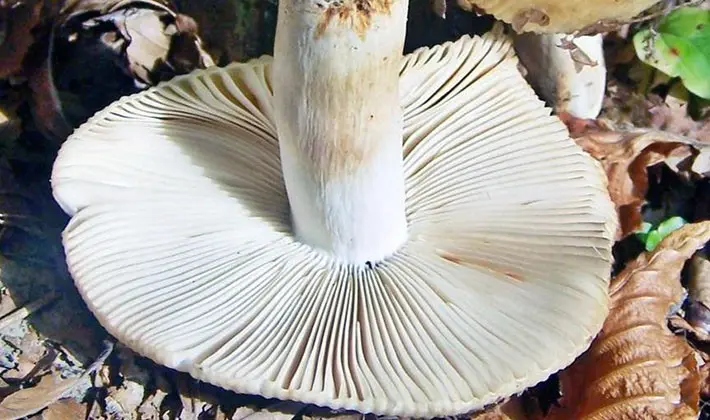
The flesh is white, then ocher, dense in the cap, spongy in the stem, loose with an unpleasant odor and taste. The unpleasant odor is intensified in old mushrooms.
The plates are adherent, yellowish or creamy-brown with brownish spots, forked-branched, frequent, usually emitting liquid droplets along the edge. Spore powder is white or cream.
Variability. The color of the cap can vary greatly, from orange-brown to light yellow, and the blades can vary from light yellow and cream to brown.
similarity to other species. Valui is a bit like a conditionally edible ocher-yellow russula (Russula ochroleuca), in which the color of the cap is ocher-yellow with a greenish tint, the stem is smooth, cylindrical, whitish. The shape of the cap is especially different: in young and mature values, it is spherical or hemispherical and only later becomes flat, like in russula.
Cooking methods: salting after pretreatment.
Edible, 4th category.
Млечник и краснушка

Млечники и краснушки — все съедобные грибы. Среди них есть особенно ароматные и вкусные, например, млечники древесинные, отличающиеся необыкновенным контрастом цветов шляпки и пластинок. Однако все они требуют предварительного отмачивания перед окончательной засолкой.
Milky wood, or brown (Lactarius lignyotus).
Habitats: хвойные леса, среди мха, растут обычно группами.
Season: Aug. Sept.
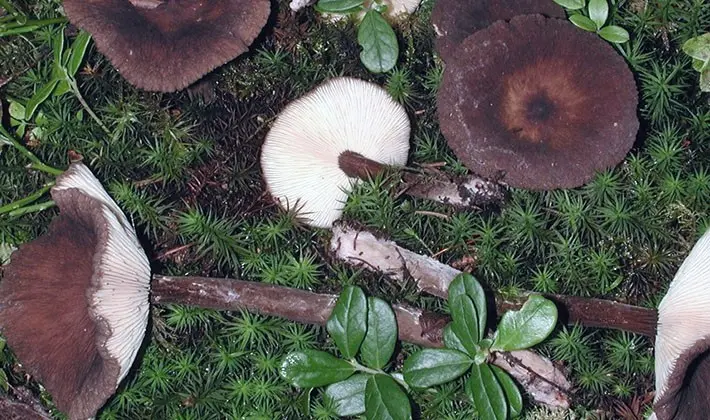
The cap has a diameter of 3-6 cm, dense, smooth, convex at first, later flat-conical. A distinctive feature of the species is an unusual combination of colors: a dark, chestnut, brown, dark brown or black-brown hat, often with a noticeable tubercle in the middle, bright and light plates and a dark blackish leg.
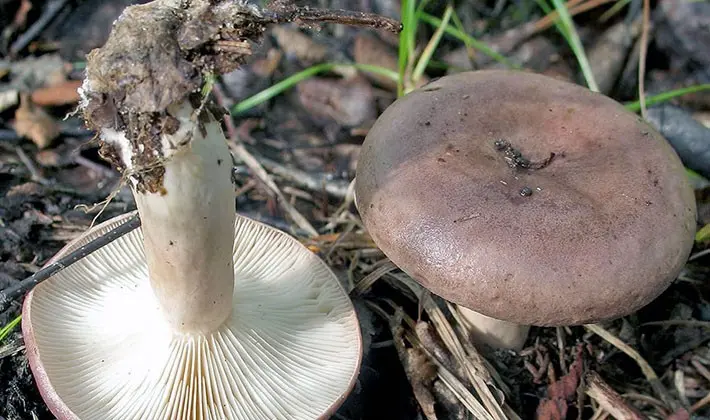
The stem is long, 4-12 cm tall, 0,6-1,5 cm thick, cylindrical, often sinuous, dark brown, blackish, brown, chestnut in color of the cap.

The flesh is white, later slightly yellowish, reddish on the cut.
The plates are frequent, slightly descending along the stem or adherent, light cream or yellowish cream.
Variability. The color of the cap and stem can vary from dark brown to brown and black-brown.
similarity to other species. The mushroom is so characteristic and contrasting in the dark color of the cap, legs and light plates that it is easily distinguished from others and does not have closely similar species.
Cooking methods: cooking, salting, hot.
Edible, 2th category.
Rubella (Lactarius subdulcis).
Habitats: лиственные и смешанные леса, растут группами.
Season: July – October.

The hat has a diameter of 4-9 cm, is dense, but breaking, shiny, first convex, later flat-prostrate, slightly depressed in the middle. The surface is matte, smooth or slightly wrinkled. A distinctive feature of the species is a rusty-reddish, red-brown, yellowish-brown color.
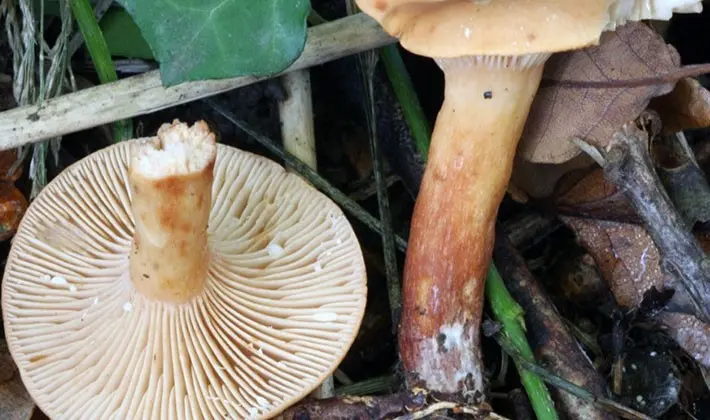
Leg 3-7 cm high, 0,6-1,5 cm thick, cylindrical, slightly narrowed at the base, sometimes with longitudinal fleecy stripes, smooth, brownish.

The pulp is fragile, brownish-yellowish, with a slight unpleasant odor and bitter taste.
The plates are frequent, narrow, slightly descending along the stem, light brown. When cut, a liquid milky white juice is released, at first sweetish, but after a short time it begins to taste bitter.
Variability. The color of the cap and stem can vary from rusty red to dark brown.
similarity to other species. Rubella is similar to bittersweet (Lactarius rufus), which has whitish flesh instead of brownish-yellowish and has a central tubercle.
Cooking methods: conditionally edible mushroom, as it requires preliminary mandatory boiling, after which it can be salted.
Edible, 4th category.
In the final section of the article, you will find out which inedible mushrooms grow in July.
Inedible mushrooms in July
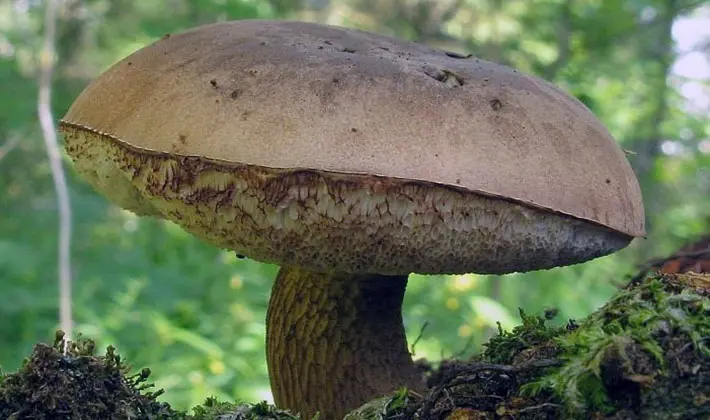
Gall fungus (Tylopilus felleus).
In the dense and dark forest, exclamations are often heard: “I found boletus! Also, there are several of them! On closer examination, it turns out that these mushrooms have pinkish plates. From a distance, they really look like porcini mushrooms or boletus. Some even boil them. They are non-poisonous, but very bitter. These are gall fungi.
Medicinal properties of gall mushrooms:
- The gall fungus has a choleretic effect. From it prepare drugs for the treatment of the liver.
Habitats: damp places in coniferous and mixed forests, near rotten stumps, occur singly and in groups.
Season: July – October.
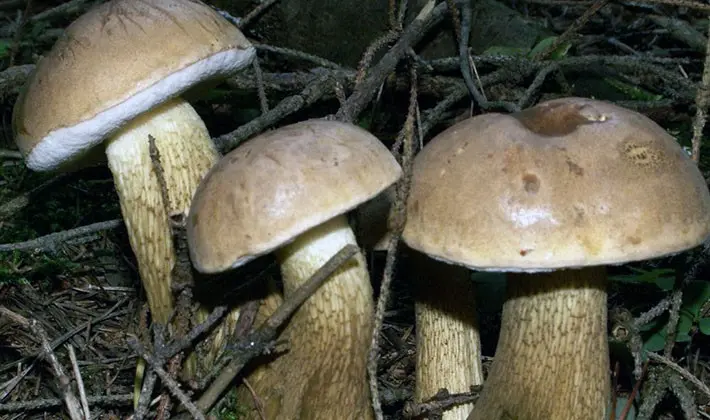
The cap has a diameter of 4 to 15 cm, thick-fleshy, at first hemispherical, later round-cushion-shaped and then prostrate or flat-convex. The surface is slightly velvety, later smooth, dry. Color: light chestnut, brownish-brown with gray, yellowish or reddish hues.
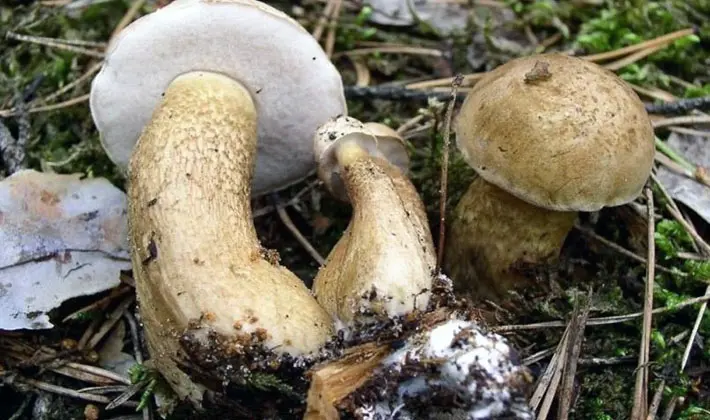
Leg 4-13 cm high and 1,5-3 cm thick, first cylindrical, later club-shaped at the base. The color of the stem is cream-buff or yellowish-brown. On top of the leg there is a clear dark black-brown mesh pattern.
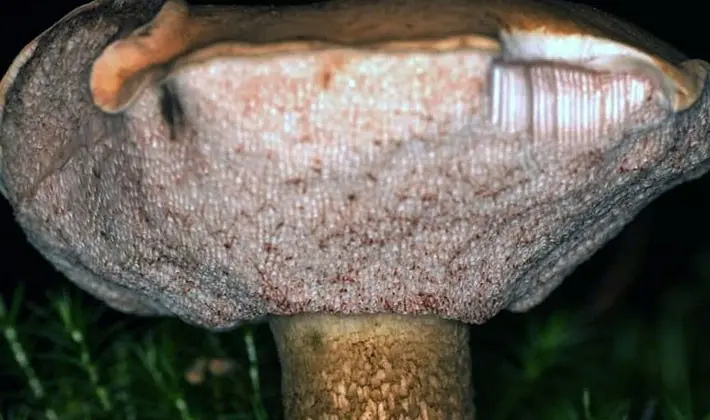
The pulp is dense, thick, pure white, loose in old mushrooms, turning pink at the break. A distinctive feature of the species is the burning-bilious taste of the pulp, although the smell is pleasant, mushroom.
The tubular layer is adherent at the stem, sometimes notched. The second distinguishing feature of the species is the pale pink or dirty pink color of the down and tubules. When pressed, the layer turns pink. In young mushrooms, the color is almost white. The pores are rounded or angular, small. Spore powder – grayish-brown, pink-brown, pink.
Variability. The color of the cap during the growth of the fungus changes from light brown to brownish-brown, and the tubular layer changes from white to pink.
Similar types. At a young age, when the tubules are white, the gall fungus can be confused with different types of ceps. However, the pulp of the white fungus is tasteless and white, does not change color when broken and, most importantly, does not have a very bitter taste.
Inedible, have a burning-bitter taste.
Float

July floats stand out well in the grass. These cute, slender mushrooms with a long stem, although inedible, always attract mushroom pickers.
White float (Amanita nivalis).
Habitats: deciduous and mixed with birch forests, grow either in groups or singly.
Season: August – October.

The cap is thin, has a diameter of 3-6 cm, at first ovoid, later convex-prostrate and completely flat. A distinctive feature of the species is a snow-white small-scaled hat with a blunt tubercle, with shading along the edges and a long and thin whitish stem with a Volvo. The edges of the cap are smooth at first, later wavy.
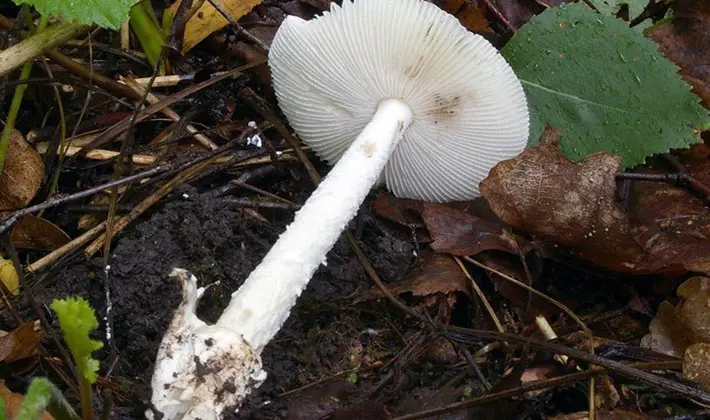
Ножка длинная 5-16 см высотой, 5-10 мм толщиной, гладкая, сначала белая, позже светло-кремовая с крупными чешуйками.

Pulp: whitish, watery, brittle, odorless.
Пластинки свободные, частые, мягкие, белые.
Variability. The color of the cap varies from white to whitish with a tubercle.
Similar types. The inedible snow-white float is similar to young specimens of the poisonous toadstool (Amanita citrine), which is distinguished by a large white ring on the stem and a thick, fleshy hat.
Inedible.
Float ocher-gray (Amanitopsis lividopallescens).
Habitats: deciduous and mixed forests, grow either in groups or singly.
Season: August – October.
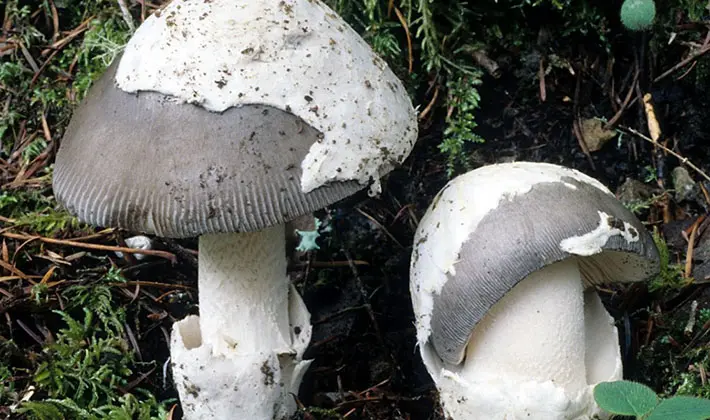
The cap is thin, has a diameter of 3-7 cm, at first hemispherical, later convex-prostrate and completely flat. A distinctive feature of the species is an ocher-gray hat with a blunt tubercle, an uneven surface and cracking edges over time. In young specimens, the central region of the cap is lighter, almost white.

The leg is thin, long, 5-12 cm high, 6-15 mm thick.
The top of the leg is whitish, the bottom is the same color as the hat. The base of the leg is thickened.
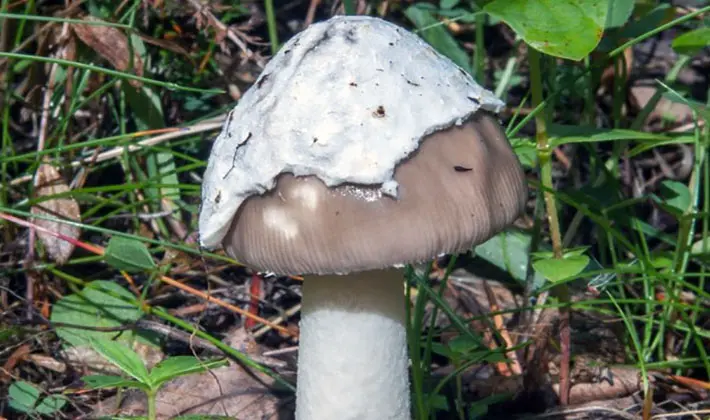
Pulp: whitish, odorless.
The plates are frequent, soft, white, notched-attached.
Variability. The color of the cap varies from ocher gray to whitish and yellowish.
Similar types. The inedible silver float is similar to the poisonous white form of the pale grebe (Amanita phalloides), which is distinguished by the presence of a wide ring on the stem and the absence of shading on the edges of the cap.
Inedible.
Pale toadstools.
- Pale grebes are deadly poisonous, that’s why they are grebes.
Pale grebe, white form (Amanita phalloides).
Habitats: deciduous and mixed forests, on humus-rich soil, grow either in groups or singly.
Season: August – November.
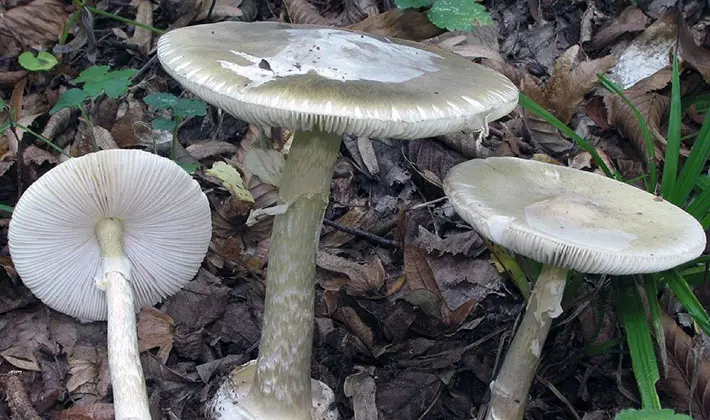
The cap has a diameter of 6-15 cm, at first hemispherical, later convex prostrate. A distinctive feature of the species is a smooth fibrous whitish surface of the cap without scales and a stem with a Volvo and a wide ring.
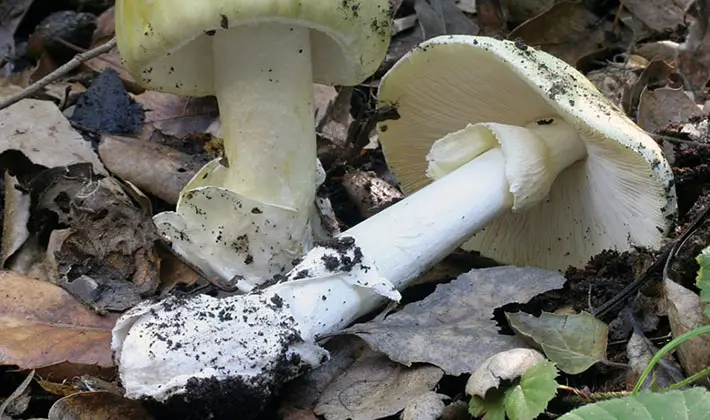
Leg 6-16 cm tall, 9-25 mm thick, white, smooth. In the upper part of the leg, young specimens have a wide white ring. The ring may disappear over time. At the base of the leg has a tuberous thickening, covered with Volvo.
Pulp: white, yellowish under the skin, with a subtle smell and taste.
The plates are free, frequent, soft, short, white.
Variability. The color of the cap changes little – it is either pure white or whitish with pinkish spots.
Similar types. You need to be especially careful when collecting good edible champignons – meadow (Agaricus campestris), large-spore (Agaricus macrosporus), field (Agaricus arvensis). All these champignons at an early age have light plates with a slight yellowish or slightly noticeable pinkish tint and light caps. At this age, they can be confused with the deadly poisonous pale grebe. In adulthood, in all these champignons, the plates become light brown, pink, brownish in color, while in the pale grebe they remain white.
Deadly poisonous!
Waxy talker (Clitocybe cerussata).
Among the talkers, most of the inedible and even poisonous mushrooms. They can be distinguished by a cone-shaped stem and plates crawling onto the stem. In July, one of the most poisonous is found – a waxy talker.
Habitats: mixed and coniferous forests, in grass, on sandy soils, grow singly or in groups.
Season: July – September.
The cap is 3-7 cm in diameter, first convex, then prostrate and convex-depressed. A distinctive feature of the species is a waxy or whitish hat with whitish concentric zones and wavy edges.
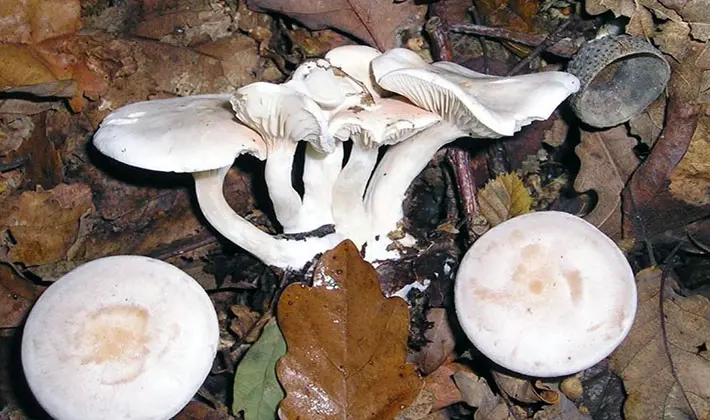
Leg 3-6 cm tall, 4-12 mm thick, cream or whitish with thinning and pubescence at the base.
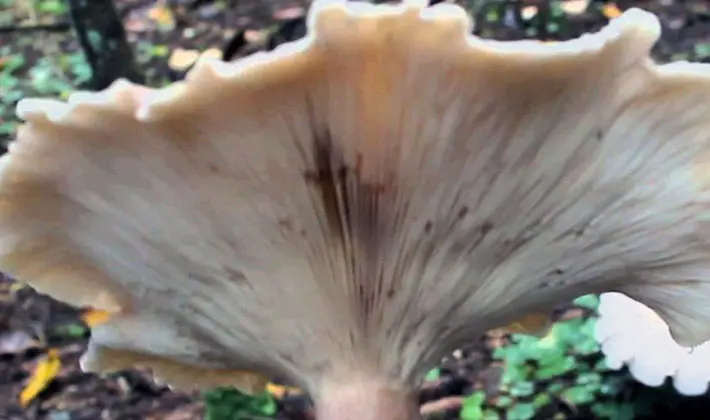
The flesh is white, brittle, with an unpleasant odor.
The plates are frequent, narrow, strongly descending along the stem, whitish at first, later white-cream. Spore powder is white.
Variability: the color of the cap varies from white to ivory and white-cream.
Similar types. The waxy talker is similar to the poisonous whitish talker (Clitocybe dealbata), which is slightly funnel-shaped and has a strong mealy smell.
Poisonous.









